Lona Manning's Blog
November 18, 2025
CMP#235 Four volumes of sheer tedium
 This blog explores social attitudes in Jane Austen's time, discusses her novels, reviews forgotten 18th century novels, and throws
some occasional shade
at the modern academy. The introductory post is here. My "six simple questions for academics" post is here. Spoilers abound in my discussion of these forgotten novels, and I discuss 18th-century attitudes which I do not necessarily endorse. CMP#235 Medieval Snoozefest -- The Duke of Clarence (1795), by Mrs. E.M. Foster
This blog explores social attitudes in Jane Austen's time, discusses her novels, reviews forgotten 18th century novels, and throws
some occasional shade
at the modern academy. The introductory post is here. My "six simple questions for academics" post is here. Spoilers abound in my discussion of these forgotten novels, and I discuss 18th-century attitudes which I do not necessarily endorse. CMP#235 Medieval Snoozefest -- The Duke of Clarence (1795), by Mrs. E.M. Foster
 What a snoozer! Chatgpt art Boy, what a slog. Frankly, I skimmed through most of this book. I had assumed that The Duke of Clarence was an historical novel but as it turns out, it’s a gothic novel set in England and France in the 15th century. Gothic novels aren’t my thing. I just can’t get excited about abducted and immured heroines, evil priests, secret passages, dastardly noblemen, and garrulous servants. So I confess—I didn’t catch every little detail explaining how and why our nobly-born hero Edgar De Montford ended up being mislaid and becoming a foundling.
What a snoozer! Chatgpt art Boy, what a slog. Frankly, I skimmed through most of this book. I had assumed that The Duke of Clarence was an historical novel but as it turns out, it’s a gothic novel set in England and France in the 15th century. Gothic novels aren’t my thing. I just can’t get excited about abducted and immured heroines, evil priests, secret passages, dastardly noblemen, and garrulous servants. So I confess—I didn’t catch every little detail explaining how and why our nobly-born hero Edgar De Montford ended up being mislaid and becoming a foundling.But the never-ending backstories with their thwarted love affairs and general perfidy--I mean, if you were a noblewoman unjustly immured in a tower for sixteen years and out of nowhere, two different people find you—coincidentally on the same night—and they asked you, Oh my god, what happened? Who put you here? would you give them a brief precis as you were running through the door to freedom, and maybe get into the details later after you've had a hot bath and a good meal? Or would you spend hours telling them the whole story from the beginning, recalling entire conversations and your every gesture with it? I’d be high-tailing it out of there.
As bad as this book is, I will say in justice to this authoress, and in contrast with Eliza Kirkham Mathews' youthful effort The Phantom, the backstories at least all tie together and relate to the central mystery of the story.
 Joan of Arc So, in terms of my project of reading novels that were perhaps written by the same person who wrote The Woman of Colour, I have decided that academic rigour doe not require that I read The Duke of Clarence carefully because it is a completely different genre than The Woman of Colour. There won’t be many similarities in terms of plot points at any rate.
Joan of Arc So, in terms of my project of reading novels that were perhaps written by the same person who wrote The Woman of Colour, I have decided that academic rigour doe not require that I read The Duke of Clarence carefully because it is a completely different genre than The Woman of Colour. There won’t be many similarities in terms of plot points at any rate.The Duke of Clarence could very well have been written by the author of Rebecca. Both books feature highly emotional and overwrought language from both male and female characters (as of course do many other novels of the era). Rebecca had a fat character, Mrs. Nesbitt, who was held up to ridicule. In The Duke of Clarence, the evil priest is a fatty, who “waddled out” of heroine’s apartment, “with all the haste his corpulent person would admit of,” and he actually later dies after he trips because he’s so fat.
Although the emotions run high and the dialogue is florid, the narration really plods in this book. As in Rebecca, people's movements are described with clunky amateurish prose. Here, the nasty uncle arrives at the castle after Elfrida's father dies. She's up in her chamber crying, so her father's ward, Edgar, receives the earl. “Where is my brother’s chaplain, sir?” demanded the earl.
“I will desire him to attend your lordship,” replied Edgar, pleased at a pretext to quit the room.
“Do so sir, and I will thank you.”
Edgar withdrew, and presently met with Anthony, who was hastening to the earl—“The earl inquires for you, father.”
“You have seen him then, my son?”
“I have—ah, how much unlike his noble relative! But he is the uncle of Elfrida, and as such I respect him—but his lordship will be impatient.”
“I will attend him immediately,” said Anthony, leaving the youth.
 The Duke of Clarence fell in the Battle of Baugé, France, 1421 Page after page of this plodding stuff...
The Duke of Clarence fell in the Battle of Baugé, France, 1421 Page after page of this plodding stuff...As with Rebecca, the misunderstandings between the lovers are unconvincing and artificially protracted. Elfrida’s father, on his deathbed, gives her permission to marry Edgar if he comes back triumphant from the latest campaign in France, but being a modest maiden, she can’t share the good news with Edgar, so they have a ridiculous conversation. “Deeply blushing,” she promises him (referring to herself in third person) “Elfrida will not, shall not, marry any but him her father has selected for her husband,” which sends Edgar into a rage of despair because he has no reason to assume that he’s the lucky guy.
He goes to France to help the king hold on to the French territories won by Henry V, which means they are up against Joan of Arc, who is mentioned but who does not appear in the story. He's falsely accused of ravishing a married woman, so further misunderstandings arise between him and Elfrida.
The authoress of this book can never decide if her hero is performing “miracles of valour,” or if he is participating in an immoral, unjustified war. In one chapter, Edgar “persevered in his glorious resolve” for a cause which should “animate every Briton’s arm.” In another chapter, the authoress upbraids the king for his absurd pretensions to the throne of France and being “deaf to humanity, actuated alone by the desire of conquest and monopolizing power, he has been the means of destroying thousands, and of leaving their helpless families a prey to poverty and sorrow!”
But considering that this is a female author, she tackles warfare and battle with more brio than many other female authors--as we know, Austen stayed away completely from warfare scenes.
 Vengeful ghost A hard-won happy ending
Vengeful ghost A hard-won happy endingWell, in case you're on tenterhooks, Edgar and Elfrida do manage to make it to the altar, after several separations and misunderstandings. And after having to listen to a lot of backstories.
Two ghosts appear in the story and I assumed that at some point we’d learn that they are not real ghosts, but somebody dressed up as a ghost (the Scooby Doo ploy), but by golly, there was no such explanation. The reviewer for The Monthly Review thought including real ghosts was an “absurdity” and “an injury to young minds to impress on them, in tales of this kind, the belief of their real existence.”
It’s a mystery to me why this book was republished in Dublin and reprinted in 1831, but it was.
I’ve still got at least one more historical title to look at, Jacquelina of Hainault (1798). There was a real historical Duke of Clarence who was killed in battle in France but he was not married to someone named Emmeline and he had no son named Edgar.
The foundling who turns out to be of noble birth is of course a staple of novels of the long 18th century. Scholar Elizabeth Neimann calls this type of novel a “providential” novel, "built on the secret nobility of the hero or heroine. Yet this is an open secret; the hero’s exceptional good looks and virtuous mind unsubtly signal his real identity to readers as does his pervasive feeling of discomfort when living as a commoner.” The providentiai novel assumes a conservative mindset, in that people are born noble or common, as God ordains.
Neiman, Elizabeth. Minerva's Gothics: The Politics and Poetics of Romantic Exchange, 1780-1820. University of Wales Press, 2019.
Previous post: Rebecca
Published on November 18, 2025 00:00
November 10, 2025
CMP#234 Rebecca the heroine of sensibility
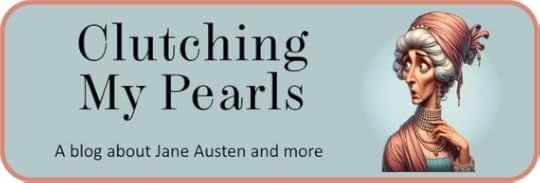 This blog explores social attitudes in Jane Austen's time, discusses her novels, reviews forgotten 18th century novels, and throws
some occasional shade
at the modern academy. The introductory post is here. My "six simple questions for academics" post is here. Spoilers abound in my discussion of these forgotten novels, and I discuss 18th-century attitudes which I do not necessarily endorse. CMP# 234 Rebecca the Heroine of Sensibility: Rebecca (1799) by Mrs. E.M. Foster
This blog explores social attitudes in Jane Austen's time, discusses her novels, reviews forgotten 18th century novels, and throws
some occasional shade
at the modern academy. The introductory post is here. My "six simple questions for academics" post is here. Spoilers abound in my discussion of these forgotten novels, and I discuss 18th-century attitudes which I do not necessarily endorse. CMP# 234 Rebecca the Heroine of Sensibility: Rebecca (1799) by Mrs. E.M. Foster
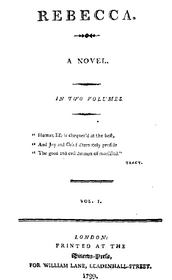 No author on title page Rebecca is one of 22 novels that may—or may not—have been written by the author of the 1809 novel The Woman of Colour, a book which has attracted a lot of academic interest in recent years. I’ve been entertaining myself by reading these novels to see if I can find similarities to The Woman of Colour.
No author on title page Rebecca is one of 22 novels that may—or may not—have been written by the author of the 1809 novel The Woman of Colour, a book which has attracted a lot of academic interest in recent years. I’ve been entertaining myself by reading these novels to see if I can find similarities to The Woman of Colour.Rebecca, published in 1799, is one of the earliest in this chain of novels which stretches from 1795, with the historical novel The Duke of Clarence, to 1817 and The Revealer of Secrets. One similarity worth noting is that the father of Olivia Fairfield in The Woman of Colour, and the father of Rebecca Elton in this novel, both tell their daughters who they should marry in their last will and testament.
I have a lot to say about Rebecca, even though it is a minor, third-rate novel. It earned only a brief literary snort from the London Review, which quoted a bit of dialogue: “Ah, Rebecca! How shall I part with you?” to which the reviewer answered: “Without a sigh!”
Yes, the dialogue is often clichéd (and exceedingly florid to our modern tastes) and the narration is stilted. In that respect, we can contrast this authoress with Jane Austen. We can compare the themes and tropes of other novels of this era, and at some point, I’ll come back to it to discuss more similarities to The Woman of Colour, but not quite yet... Raging sensibility
The authoress of Rebecca, who has been identified as “Mrs. E.M. Foster,” claims to be an “Old Maid” (The “Mrs.” honorific was given to older ladies at this time even if they were single) who has never experienced “la belle passion” and who derived the details of her love story “from other tender works.” However, her love-scenes are not terse and contained, as with that more famous spinster, Jane Austen. Rebecca is more than a sentimental novel, this is a novel of sensibility. Rebecca's admirers rant, fall on one knee, smite their breasts, and weep. “Oh Rebecca! I cannot suppress my love, my adoration, which at this instant almost madden me… on you alone depends my every moment of future comfort; from the first hour I beheld you, you were the mistress of my fate.”
But so what if Mrs. Foster's writing lacked originality? Modern scholars like Elizabeth A. Neiman speak of the “intertextuality” of the Minerva Press novels. This stable of authors engaged, in a way, in a collaborative effort. The same stock characters, the same sentiments, the same tropes, reappear in many of them. Minerva Press readers knew what they were getting when they borrowed a Minerva novel from the circulating library and this was perhaps the secret to their success in the literary marketplace.
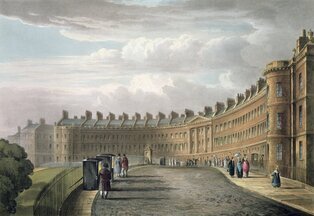 Lansdowne Crescent, Bath A Heroine Enters the World
Lansdowne Crescent, Bath A Heroine Enters the WorldWe meet our beautiful heroine--with her naturally curling hair left unpowdered and dressed in a simple but becoming muslin gown--as she arrives in Bath, where she is instantly dismayed by the contrast between her country home, with its “balmy fragrance of nature in the spring, and... the genial warmth of the sun” and the home of her aunt, with its “sickly glare,” and the “overpowering perfume of rooms, which were prepared for… the most fashionable and brilliant of the company who remained at Bath so late in the season.”
To be fair, something weighs heavily on our Rebecca's mind; her parents want her to marry Reuben Manly, the son of their good friends, the local parson and his wife. They’ve known each other since their infancy and he’s a great guy. But, sighs Rebecca, “I love him with the pure, the disinterested affection of a sister, far different from the tumultuous passion which he professes toward me.”
In Bath, Rebecca's aunt Mrs. Mellville and her cousin Caroline are kind to her. Caroline is saucy and vivacious, except when the subject of Reuben Manly comes up, then she turns red and pale by turns. They all jaunt off to Teignmouth (which is spelled T------- for some reason), and stay at the B----a V----a, that is, the Bella Vista, which is where Jane Austen and her family also stayed in 1802 and 1804. This sea-side resort boasts a circulating library, public rooms, and bathing-machines. And a cast of crazy characters!
 Grok-created illustration Personalities and Plots
Grok-created illustration Personalities and PlotsThe Mellvilles socialize with the typical and varied cast of characters who always populate novels of this era. Each one represents a particular moral or social failing which surprises, amuses, or repulses the heroine. There's the oily army captain with his extravagant compliments. The hyperactive Miss Selby goes for long walks and arrives with muddy half-boots and muddy petticoats. The fat and hypochondriacal Mrs. Nesbitt is caught by one visitor: “ravenously devouring a great plate of toast, swimming in oiled butter, the transparent liquid emerging from the corners of her ambrosial mouth.” One is reminded of Austen’s Arthur Parker in Sanditon.
A pair of spinster sisters, the Miss Brownes, do not come in for the usual ridicule meted out to old maids, such as we find with Susan and Diana Parker in Sanditon. They have accompanied their friend Mr. Digby to Teignmouth in the forlorn hope that he will recover his health. Rebecca joins them in attending to Mr. Digby’s bedside as he dies of a broken heart. For one thing, his wife treats him terribly, then she deserts him and runs off with a fortune-hunting soldier. Mr. Digby takes this a lot harder than Mr. Rushworth in Mansfield Park, perhaps he was already consumptive or already heartbroken because his beloved younger sister and his brother-in-law just up and disappeared a few years ago. Nobody knows where they went. If only he could find his sister before he dies!
Rebecca’s got another interesting mystery to ponder—while out on a long morning walk, she comes across a cottage where a young woman and her little daughter live in utter seclusion and secrecy under an assumed name. Who could this woman be?
 Colorized by Grok Love amidst the bed pans
Colorized by Grok Love amidst the bed pansAt any rate, Mr. Digby’s brother. Captain Clarence Digby, also comes to Teignmouth to succor him as he’s dying and he falls in love with Rebecca. But “insurmountable obstacles” keep them apart! One obstacle is Rebecca’s vacillation and timidity over whether she should marry Reuben to please Reuben and their respective families. By the terms of her father's will, half of her substantial fortune goes to Reuben if she marries him, but she doesn’t care about that, and she is willing to gift him with half of her fortune anyway, as a sort of consolation prize for not marrying him. But he wouldn't take the money from her, so that’s not really an issue. Altogether, I found these obstacles unconvincing. Just spit it out, girl.
Rebecca is prone to feeling the most exquisite sensations of pity and pain, so she spends a lot of time weeping. I think there must have been a kind of fashion for pale and wan heroines at this time. Like “heroin (not heroine) chic” on the fashion runway. What girl today would be pleased if the man they loved showed up and spoke with concern of her “pallid cheek” and “languid eye”? No woman likes being told that they look tired. Well, Clarence confesses his love to Rebecca, pallid or not, but he thinks Rebecca is engaged to Reuben so, after heaving many a sigh, he takes himself off to the battlefield in despair.
 The Reading Rooms at Teignmouth, Thomas Allam, 1830 Staunch conservatism
The Reading Rooms at Teignmouth, Thomas Allam, 1830 Staunch conservatismThis kind of dramatic sensibility is associated with the Romantic era, but the novel also has an emphatically conservative and anti-Jacobin subplot, which warns against the excesses of radicalism. It turns out that Mr. Digby’s missing brother-in-law Mr. Selby was an idealistic young fellow caught up in the dawn of the French Revolution. He goes to France, gets fleeced out of his fortune, then is betrayed and sent to prison. Rebecca’s mysterious cottage-dwelling friend is of course the anguished Mrs. Selby. There is no good reason why this should not have all come to light well before the latter half of the second volume and the only reason it didn’t is the unconvincing behaviour of all involved.
For this and other reasons, Rebecca reads very much like a debut novel, although according to the attribution list, it’s Mrs. Foster’s fourth effort. You would think that by her fourth novel she would know not to name one character “Miss Selby” and another “Mrs. Sedly.”
Some of the group dialogue is lively and natural-sounding, but her narration often reads like a stage direction (“Saying this, the two cousins separated”) and she relies, again and again, on illness and impending death for her plot points. Three couples in this book fall in love when the man admires how well the girl conducts herself while nursing a dying invalid. Illness and death is used to move her characters from point A to point B, or to keep them at point A when they want to go to point B. By contrast, Austen needed to get the Grants out of the way and strike Thomas Bertram with a nearly-fatal illness in Mansfield Park, and she does it with some clever sleight of hand.
 Austen's cousin Eliza de Feuillide Anti-feminist message
Austen's cousin Eliza de Feuillide Anti-feminist messageModern academics are in the habit of looking for feminist subtexts and rebukes of the patriarchy in these old novels, and it seems that the best recommendation you can give a forgotten novelist is to call her a feminist. Scholars on the hunt for feminism or other "isms" vastly outnumber scholars who acknowledge the most obvious in-your-face aspect of these novels, which is their Christian moralism. As for the feminism… well, you have to dig for it and ignore countervailing evidence. What about the many critical portraits of women who have plenty of power and who use that power against men? That includes The Woman of Colour, where the villain is a woman.
Unfeminine women are unambiguously condemned in this novel. “Did every female talk and act like [Caroline and Rebecca],” Reuben opines, “the ladies would soon regain that place in the estimation of mankind, which their monstrous and glaring violations of nature have robbed them of.” Poor Mr. Digby is portrayed as being unable to keep his wife under control: “Rebuke, remonstrance had no avail; they returned to England, her conduct still the same, his spirits broken… till unable to bear up against the destruction of all his hopes, and all his happiness, he has yielded to her sway, and, too weak to resist its attacks, is declining to the peaceful grave, the melancholy victim of a mercenary female.” The Amazonian Miss Selby—who admires Mary Wollstonecraft and calls her a “genius”--drowns after taking up gondola-paddling.
On the other hand, a virtuous women can come to grief as well. Through her backstory, we learn that Mrs. Selby unquestioningly follows her husband to revolutionary France and then he instructs her to escape back to England and hide incognito until he can clear his name and return. He never does, and she misses the chance to see her dying brother. Then she learns that her husband has been sent to the guillotine, then her little daughter dies and she goes crazy; all of this seems a disincentive for wifely obedience and feminine submission and an incentive for substituting your own better judgement.
 Ouch! Sarcastic review from the Monthly Review. Just as with our previous novel, the heroine does not marry her childhood companion, but marries someone else. Rebecca and Clarence finally sort themselves out, and Reuben consoles himself by falling in love with saucy cousin Caroline, who has always loved him.
Ouch! Sarcastic review from the Monthly Review. Just as with our previous novel, the heroine does not marry her childhood companion, but marries someone else. Rebecca and Clarence finally sort themselves out, and Reuben consoles himself by falling in love with saucy cousin Caroline, who has always loved him. I have just started in on The Duke of Clarence, where the beautiful heroine Elfrida, of noble birth, is growing up in a castle in Wales alongside Edgar, her father's ward, who is the natural son of a knight who died penniless (or is he?). What could possibly go wrong? Mrs. Foster followed up Rebecca with Miriam (1800) and Judith (1800) If the attributions are correct, she also wrote some historical fiction, including The Duke of Clarence.
Top level quiz for Janeites: Did you notice the "sickly glare" that appalls Rebecca when she goes from the city to the country? Remind you of anything?
Here is a brief summary of The Woman of Colour, another modern academic recap which manages to discuss a Christian evangelical novel without once mentioning the religious faith which inspires and consoles the heroine in good times and bad. Is it just considered bad form to mention religion these days?
Jane Austen’s cousin Eliza de Feuillide’s husband the Comte de Feuillide met his end at the guillotine as well. I’m sure relatively few English families could boast this distinction.
Neiman, Elizabeth A. Minerva’s Gothics : The Politics and Poetics of Romantic Exchange, 1780-1820 University of Wales Press, 2019.
Previous post: Substance and Shadow
Published on November 10, 2025 00:00
November 6, 2025
CMP#233 Mary, the Fanny-like heroine
 “Though I am mute, I am not always unobserving.” “it had even the power of partly raising Lady Lauretta from her recumbent attitude, who had almost given it her attention.”“Mary, who always felt too insignificant in her own estimation, to take umbrage at any rudeness which was offered to her, very readily agreed to be of the party.” -- Some quotes from Substance and Shadow for the delectation of Mansfield Park fans.
“Though I am mute, I am not always unobserving.” “it had even the power of partly raising Lady Lauretta from her recumbent attitude, who had almost given it her attention.”“Mary, who always felt too insignificant in her own estimation, to take umbrage at any rudeness which was offered to her, very readily agreed to be of the party.” -- Some quotes from Substance and Shadow for the delectation of Mansfield Park fans.Substance and Shadow, or, the Fisherman’s Daughters of Brighton, a Patchwork story in four volumes by the author of Light and Shade, Eversfield Abbey, Banks of the Wye, Aunt and Niece, etc. etc. Minerva Press, 1812. CMP#233 Substance and Shadow, a forgotten novel with a lot of Austen parallels
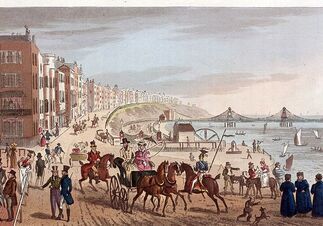 Brighton, T. Cruickshank (detail) 1824 Substance and Shadow opens with a genteel lady watching a storm blow in to the shore at Brighton, then a fashionable watering place patronized by the Prince of Wales. Mrs. Elwyn is amused by the rhapsodies of another young lady gamboling along on the beach, exclaiming over the tremendous crashing of the waves. We have here the same dichotomy Jane Austen used in Sense and Sensibility. Clara Elwyn “knew that romance and enthusiasm were the leading features of the day, and that those feelings were nurtured and indulged, at the hazard of running counter to all the forms and usages of society, and the good old way in which she had been taught to walk.”
Brighton, T. Cruickshank (detail) 1824 Substance and Shadow opens with a genteel lady watching a storm blow in to the shore at Brighton, then a fashionable watering place patronized by the Prince of Wales. Mrs. Elwyn is amused by the rhapsodies of another young lady gamboling along on the beach, exclaiming over the tremendous crashing of the waves. We have here the same dichotomy Jane Austen used in Sense and Sensibility. Clara Elwyn “knew that romance and enthusiasm were the leading features of the day, and that those feelings were nurtured and indulged, at the hazard of running counter to all the forms and usages of society, and the good old way in which she had been taught to walk.”But Mrs. Elwyn is concerned because she knows that a fisherman and his wife had gone out to sea that morning, and have not returned. The following morning brings the sad news that they are drowned, and Mrs. Elwyn benevolently visits the humble cottage where their twin infant daughters are being cared for by a neighbor woman. The babies will now become the responsibility of the parish and their prospects are bleak. Suddenly, the excitable young lady, also drawn to the news of the catastrophe, swoops in and carries off one of the babies. Mrs. Elwyn decides to give a home to the other. It will give her someone to care for, since she is childless and her husband is polite but remote and often absent... An experiment in education
So, we have the situation of twin girls separated almost at birth, and raised in completely different ways. This is yet another novel which stresses the importance of upbringing and education in the formation of character, and hence, one’s destiny in life.
When Mrs. Elwyn asks for her husband’s permission to foster little Mary in their home, he responds with: what a coincidence! He wants to introduce a little boy into the household, who is the…. uh…. the orphaned son of a good friend whom he had never happened to mention before. His name is Henry.
Mrs. Elwyn raises Mary while Henry spends most of his time at boarding school and university and Mr. Elwyn sinks into stupid lethargy. She aims to make little Mary into a “reasonable and rational being” so “rational and reasonable ideas must be implanted in her mind.” But don't be misled by the use of "rational" to suppose that Mrs. Elwyn is a disciple of Mary Wollstonecraft. Quite the opposite. This is definitely a conservative novel that praises virtue, modesty and forbearance. The authoress makes her intention very clear: “our design is to shew the practical advantages of a judicious education, and the stability and strength of mind which may be derived from an early knowledge of religion, and an exercise of its duties, even by a weak and timid female.."
Mary grows up to be intelligent and clever like Fanny Price in Mansfield Park, but she hides her light under a bushel, because of the “modesty of her disposition.” As a girl from a humble background elevated into a genteel household, Mary also has Fanny Price's socially ambiguous status.
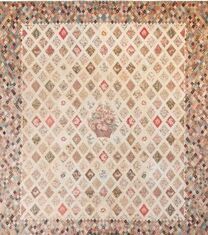 Patchwork coverlet made by Jane Austen, her mother and Cassandra Secrets come to light
Patchwork coverlet made by Jane Austen, her mother and Cassandra Secrets come to lightMrs. Elwyn dies, leaving four thousand pounds for Mary to inherit when she comes of age or marries. Mary will not be forced into getting a job, but she is stuck with living with Mr. Elwyn and a new foster-stepmother. For, after Mrs. Elwyn is buried, Mr. Elwyn’s guilty secret comes out--he confesses that he was already married when married Clara! In his youth, he secretly married the pretty sister of a school chum. The school chum died, so there was no-one to stand up for the poor girl when he lied to her and told her their marriage was invalid, due to their being underage. He married his cousin Clara for the secure family money, and parked his first wife Ellen in a cottage. They had a son. So Clara Elwyn went to her grave without knowing that her loveless, childless marriage was also bigamous and Mr. Elwyn got away with it. Henry and Clara try to adjust to this awkward new situation. On the plus side for Henry, he's acknowledged as Mr. Elwyn's legitimate son and heir.
Mr. Elwyn brings his long-neglected first wife into the mansion. Her youthful charms have fled, she is merely an underbred, uneducated woman who lives for gossip and making patchwork quilts, an occupation that for some reason, the authoress scorns.
The neighborhood is also enlivened by the arrival of a couple recently returned from India: General Maxwell and his much older wife. They have houseguests too, Lady Lauretta and her daughter Lauretta Montgomery. This young lady bears an uncanny resemblance to Mary, except that Mary dresses simply and soberly and Lauretta is decked out and groomed to the nines. Incidentally, the Maxwells, Lady Lauretta, and her daughter have all just returned from the East Indies--yet another example of how authors of the time used the Indies, East and West, to keep their characters off-stage when their absence is needed for plot purposes (cough Sir Thomas cough).
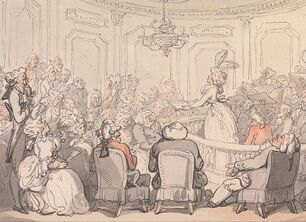 Thomas Rowlandson, "Comforts of Bath" Mansfield Park-isms
Thomas Rowlandson, "Comforts of Bath" Mansfield Park-ismsOur mild-tempered heroine just can’t approve of Lauretta Montgomery and her flirtatious ways, but Henry is besotted with her. Mary can’t understand how Henry is “blind” to the faults of both mother and daughter: “‘His perception, his discernment, are usually not defective; is it possible that he cannot see it? Or is it possible that I see it through a prejudiced medium?' and then would she take herself to task, and try to discover whether to malice, envy, or uncharitableness, she could impute her opinions on this subject.”
At least Mary, unlike Fanny, has the advantage of an impartial bystander who sees things as she does—the blunt but kindly old neighbour Mr. Munsden.
Mr. Elwyn suddenly dies, and the widow Elwyn, the addle-pated Ellen, soon marries one of her male servants. To escape this trying situation, Mary goes to live with Mr. Munsden’s widowed sister in Bath. While there, she goes to a musical concert and encounters Henry busily courting Lauretta, and also Henry’s friend Frederic Fitzallen, who is quite taken with her.
 Rev. Thomas Secker (1693 –1768) by Reynolds Spoiler wrap up
Rev. Thomas Secker (1693 –1768) by Reynolds Spoiler wrap upFrom here, chickens come home to roost for all the characters. Henry impulsively marries Lauretta and belatedly discovers what a selfish, immature character she is. He had started this novel in the pole position for being the hero, but by volume IV he is a miserable gambler, throwing away the family fortune at the card table. Lauretta’s mother is jilted at the altar, Henry's mother is miserable in her marriage to the servant, while Mary has enough money to take a nice cottage with her friend Miss Letsom. The young ladies are quite content in their new life and I think the authoress promotes the desirability of a quiet life of self-sufficiency--but on the other hand, this is a four -volume novel so the heroine should get a marriage by the end of it. And she does, to Mr. Fitzallan, now Sir Frederic on the death of his father.
The authoress finishes off by quoting Thomas Secker, the Archbishop of Canterbury: “Length of days, easy circumstances, general esteem, domestic tranquility, national good order and strength, are the smaller advantages that usually attend practising the rules of religion; but the constant ones, the calm peace, and joyful prospects, of all whose minds are duly affected by the genuine principles of it, these are blessings inexpressibly great.”
Heroine Mary is a sympathetic character despite being a heroine in the gentle, forbearing Fanny Price mode. She is free of Fanny’s tendency to passive-aggressiveness. She acts quickly when Lauretta's muslin gown catches fire, grabbing a shawl to smother the flames--what would Fanny have done in the same situation?
Substance and Shadow did not receive any reviews when it was published, but I found it to be fairly engaging and it kept me guessing whether Mary would end up with Henry or Frederic. The authoress makes good use of all her characters in her plots and subplots. The hero is introduced late into the story but he is the one who takes the initiative of visiting Brighton to confirm that Lauretta and Mary are sisters and of legitimate birth. This is to counteract a malicious rumor that the late Mrs. Elwyn had an illegitimate child and lied about Mary being a fisherman’s daughter.
I also expected to learn that somehow or other, Mary and Lauretta weren't the humble offspring of a fisherman and his wife. That their mother was perhaps of genteel birth or something--because usually foundling heroines turn out to be well-born, a notion that upholds heredity over upbringing, or nature over nurture. This author gives us a heroine who is actually a fisherman's daughter who marries a baronet. And he's happy to marry her because he recognizes her worth as a person.
About another six novels to go before I’ve read through all the novels involved in the attribution chain of The Woman of Colour. Previous post: An old review of Mansfield Park
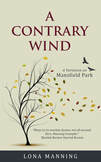 Not everybody who reads Mansfield Park is happy with Fanny Price marrying her cousin Edmund. I had to contend with this question myself as the plot for my Mansfield Trilogy unfolded. For more about my novels, click here.
Not everybody who reads Mansfield Park is happy with Fanny Price marrying her cousin Edmund. I had to contend with this question myself as the plot for my Mansfield Trilogy unfolded. For more about my novels, click here.
Published on November 06, 2025 00:00
October 28, 2025
CMP#232 A 100-year old review of Mansfield Park
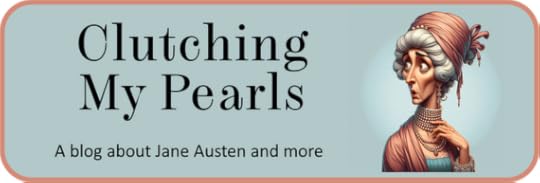 This blog explores social attitudes in Jane Austen's time, discusses her novels, reviews forgotten 18th century novels, and throws
some occasional shade
at the modern academy. The introductory post is here. My "six simple questions for academics" post is here. Spoilers abound in my discussion of these forgotten novels, and I discuss 18th-century attitudes which I do not necessarily endorse. CMP#232 An (almost) 100 year-old review of Mansfield Park I was doing some research into how the reception of Mansfield Park has changed since it was first published. It is now generally regarded as her least popular novel, and some say, her least successful novel artistically. It's a favourite of mine, obviously, since I wrote an Austenesque trilogy based on it. In my own books, I had to come to terms with the slave trade and the fact that Sir Thomas owns a plantation (called an "estate" in the book) in Antigua. The issue of slavery was not an issue for a critic writing 100 years ago, even though they were not as far removed from the time of slavery.
This blog explores social attitudes in Jane Austen's time, discusses her novels, reviews forgotten 18th century novels, and throws
some occasional shade
at the modern academy. The introductory post is here. My "six simple questions for academics" post is here. Spoilers abound in my discussion of these forgotten novels, and I discuss 18th-century attitudes which I do not necessarily endorse. CMP#232 An (almost) 100 year-old review of Mansfield Park I was doing some research into how the reception of Mansfield Park has changed since it was first published. It is now generally regarded as her least popular novel, and some say, her least successful novel artistically. It's a favourite of mine, obviously, since I wrote an Austenesque trilogy based on it. In my own books, I had to come to terms with the slave trade and the fact that Sir Thomas owns a plantation (called an "estate" in the book) in Antigua. The issue of slavery was not an issue for a critic writing 100 years ago, even though they were not as far removed from the time of slavery. I also had to deal with the widespread perception of the heroine Fanny Price as a prim little prig, or a timid little mouse. The anonymous author of this 1927 review, reproduced below, doesn't like Fanny, Edmund, or the book, but his opinions and the way he phrased them amused me. I think other Janeites would like this too, even Mansfield Park fans. But if you haven't read Mansfield Park, be advised, this review contains spoilers.
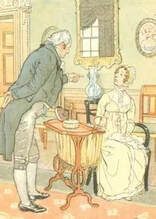 Sir Thomas and Mrs. Norris after his return from Antigua MANSFIELD PARK—JANE AUSTEN’S WORST NOVEL
Sir Thomas and Mrs. Norris after his return from Antigua MANSFIELD PARK—JANE AUSTEN’S WORST NOVELSheffield Daily Telegraph, Jan. 20, 1927
When new books fail to charm—and there comes a time when they do, and when all one’s favourite modern authors seem to be writing tiresome rubbish—there is no cure so good for the soul as to re-read old ones. We suspect that advancing age has much to do with this failure to find a new book to our taste.
To anyone suffering from this sad fate, whatever his age and literary preferences, we unhesitatingly recommend a course of Disraeli novels or those of Jane Austen.
To write of Jane Austen in general is like trying to find something new to say about the weather… Yet there remains, we think, something to be said of Mansfield Park. Perhaps it was because we read it last of all, of perhaps because it really is not so good as the others, that we must admit to finding it a very mediocre performance. Compared with the charming simplicity of Catherine Morland, the robust sense of Elinor Dashwood, the quiet intelligence of Anne Eliot or the satirical wit of Emma Woodhouse, Fanny Price is a dull and extraordinarily priggish heroine. As for Edmund Bertram, he is a prince of prigs indeed. Writers on this book have said that it is [mediocre] because in it Jane Austen tried to paint a moral lesson based on a wrong view of life, that she failed to hold the attention. If this is so we must concede that its morality (to our modern eyes amazingly overdone) is not only above question but also swamps everything in the way of humour in its overwhelming flood.
Henry and Mary Crawford are the only bright spots, and lest we should be dazzled by their charms to the extent of becoming bored with Fanny and Edmund, we are not allowed to admire them. Jane Austen is determined to be on the side of the angels, and she will not have us against her, so she makes them charming but frail. Henry is a flirt whose intentions are never honourable (save when he falls in love for a short time with Fanny) and Mary is presumed to be a monster of heartlessness because she will not marry the prim Edmund, and settle down to comparative poverty as a country parson’s wife at Thornton Lacey.
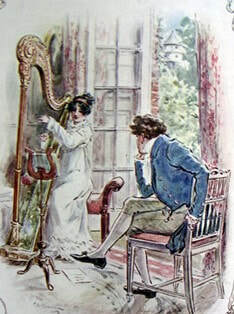 The Critic on the Hearth
The Critic on the HearthWe could never blame her. Edmund repelled us from the first. He is a well-meaning moral snob of the first quality. From the beginning, though captivated by her beauty, he criticises her conversation, behaviour, and view of life. Had Mary married him she would have had to live with the critic on the hearth to the end of her existence. But we do not believe she would have borne it so long, she must have left him, and there would have been another awful family skeleton in the Bertram cupboard.
But it is not only the behaviour of Fanny and Edmund that rouses our surprise and incredulity. The whole Bertram family are odd in their ways. When Sir Thomas is absent in Antigua a little gaiety manages to creep in (much to the horror of the two cousins) chiefly through the agency of Mr. Yates and the Crawfords. The young people proceed to erect a theatre in the billiard room, Mrs. Norris buys yards of green baize for a curtain, and private theatricals are in active rehearsal; when the sudden return of Sir Thomas at least a week before he was expected, throws them all into a fright, and the whole scheme is immediately abandoned.
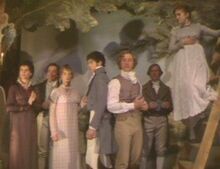 Private theatricals, 1983 version There are many things in this episode that seem not a little absurd to modern minds. First the fuss and preparation that attended the event. Present-day “young people” would not have gone about it so elaborately. They would not have needed a scene painter from London, a real stage, a baize curtain, and the rest. The play would have been got up in a week or less, and with little fuss, though doubtless with a good deal of untidiness. But it is the manifestly guilty conscience of the Mansfield Park amateurs in [the] face of their father’s return, and their prompt realisation that the whole scheme must be abandoned questioningly, that surprise us most.
Private theatricals, 1983 version There are many things in this episode that seem not a little absurd to modern minds. First the fuss and preparation that attended the event. Present-day “young people” would not have gone about it so elaborately. They would not have needed a scene painter from London, a real stage, a baize curtain, and the rest. The play would have been got up in a week or less, and with little fuss, though doubtless with a good deal of untidiness. But it is the manifestly guilty conscience of the Mansfield Park amateurs in [the] face of their father’s return, and their prompt realisation that the whole scheme must be abandoned questioningly, that surprise us most.We have learnt how parents should be brought up since then, and though a modern Sir Thomas might be pardonably vexed at finding his own study about to be used as a green room, his billiard room in a mess, and his daughter (engaged to another man) endlessly rehearing passionate love scenes with a stranger [actually, they portrayed mother and son, but Maria’s character is a “fallen woman” and hence it was indelicate for her to play the part, and it gave Henry and Maria the chance to embrace and hold hands] all these things could be got over now a-days. And in the book these are not the things which seem to upset him. It is the impropriety of such a scheme among such a party and at such a time” that he deplores, and remarks about “delicacy of her situation” follow. The said delicacy being merely due to the fact that Maria is engaged to be married and that he has been away from home, does not seem to us to put such a very dreadful complexion on the proceedings. But we have the uneasy feeling that Sir Thomas expected to find his family so stricken by his long absence as to be capable of nothing but earnest prayers for his safe return.
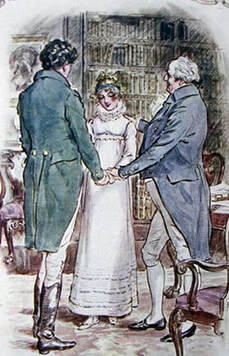 A Bore and a Prig
A Bore and a PrigHe says—“I have come home to happy and indulgent,” but does not bear out this sentiment in his actions. In short we do not have to wait long to find out just what sort of a worthy old bore he is. It is Fanny who gives him away a few pages later:--“I suppose I am graver than other people… the evenings do not appear long to me. I love to hear my uncle talk of the West Indies. I could listen to him for an hour together. It entertains me more than many things I have done; but then I am unlike other people I dare say.”
This is one of the most illuminating passages in the book, showing up Sir Thomas with his “talk of the West Indies” and Fanny, the prig, with her certainty of being unlike other people—a type we all know, and avoid when we can.
We can only rejoice in her unlikeneness to Jane Austen’s other heroines, and hope that the absolute rectitude of their impeccable characters allowed them leisure for occasional relaxation. Perhaps the strain of two prigs in one house led her (or Edmund) to rebel and seek a little healthy entertainment before it was too late. But we fear it did not, and that Fanny bore him a large family of well-behaved children, all strictly brought up, and each more perfectly prim and proper than the last.
--(article signed) R.A.G. For more, much more, on Mansfield Park, read my series on Symbolism (and slavery) in Mansfield Park, Female education in Mansfield Park, and Lord Mansfield in Mansfield Park. S ee here for my Mansfield trilogy. Previous post: Corinne/Corinna Next post: Substance and Shadow
Published on October 28, 2025 00:00
October 22, 2025
CMP#231 Clarissa, the anti-heroine
 This blog explores social attitudes in Jane Austen's time, discusses her novels, reviews forgotten 18th century novels, and throws
some occasional shade
at the modern academy. The introductory post is here. My "six simple questions for academics" post is here. Spoilers abound in my discussion of these forgotten novels, and I discuss 18th-century attitudes which I do not necessarily endorse. CMP#231 Clarissa, the anti-heroine of The Corinna of England
This blog explores social attitudes in Jane Austen's time, discusses her novels, reviews forgotten 18th century novels, and throws
some occasional shade
at the modern academy. The introductory post is here. My "six simple questions for academics" post is here. Spoilers abound in my discussion of these forgotten novels, and I discuss 18th-century attitudes which I do not necessarily endorse. CMP#231 Clarissa, the anti-heroine of The Corinna of England
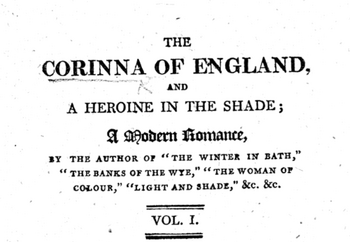 I am slowly working my way through a dozen or so novels, all belonging to a tangled attribution chain, with the intent of figuring out whether Mrs. E.G. Bayfield or Mrs. E.M. Foster is the most likely author of The Woman of Colour, a Regency-era book which has drawn much recent scholarly interest. Next up: The Corinna of England, and a Heroine in the Shade (1809), published by Benjamin Crosby and Co. The fact that the author of Corinna of England is credited as being the author of The Woman of Colour right there on the title page to the right is not enough to prove the attribution, because the waters have been considerably muddied along the way.
I am slowly working my way through a dozen or so novels, all belonging to a tangled attribution chain, with the intent of figuring out whether Mrs. E.G. Bayfield or Mrs. E.M. Foster is the most likely author of The Woman of Colour, a Regency-era book which has drawn much recent scholarly interest. Next up: The Corinna of England, and a Heroine in the Shade (1809), published by Benjamin Crosby and Co. The fact that the author of Corinna of England is credited as being the author of The Woman of Colour right there on the title page to the right is not enough to prove the attribution, because the waters have been considerably muddied along the way.At any rate, let’s turn to the novel. No, wait, we can’t do that yet, until we first explain that Corinna of England is a parody of a tremendously successful French novel, Corinne, or, Italy (1807), by the authoress and public intellectual Madame de Stael.
Corinne caused a sensation at the time but also caused a backlash in England because of its feminist heroine. Corinne is a free-spirited poet and artist who entertained men at her home, did not shy away from fame, and openly courted the man she wanted to marry. The plot of de Stael’s novel is of secondary importance, although I will note two things which struck me; one, that de Stael uses a lot of narrative philosophical interludes which put me in mind of George Elliot, and secondly, after introducing her hero, she has him heroically rescue some people from a burning building. In other words, she gives him some hero bona fides, because otherwise he’s just some rich, well-born Englishman moping around Europe. As I have learned, a lot of leading men in these old novels are not heroes in the sense of being heroic, and some in my opinion are quite unheroic.
So that's Corinne. Now, let's move on to the 1809 parody....
 The forlorn orphan meets the flamboyant heiress
The forlorn orphan meets the flamboyant heiress Scholar Miranda Kiek identifies The Corinna of England as an “anti-Jacobin” novel, meaning that it is written from a conservative English viewpoint to counter the philosophies identified with the French Revolution: “a set of beliefs referred to at the time under the catchall term of ‘new’ or ‘modern philosophy’… selfishness masquerading as utility, attacks on family and state religion, sexual voracity, grandiose but meaningless statements… and—for women in particular—a lot of attention and show. New philosophers in such novels can frequently be found advocating for atheism and free love, or knocking down some ancient edifice of England’s mythical Burkean heritage.”
The narrator of Corinne moves quickly to bring her “heroine in the shade,” the demure Mary Cuthbert, together with her flamboyant but wrong-headed cousin Clarissa Moreton (the Corinna of the title). With great narrative economy (telling not showing) she kills off Mary’s parents, a pious and upright clergyman and his wife, and sends 18-year-old Mary to live with Clarissa, who is 22 years old and also an orphan. Clarissa’s father was a successful merchant, and what we would call today a “limosine liberal.” Clarissa imbibed his progressive ideas and now holds court in the family’s old mansion (bought with new money) with a bunch of sycophants and hangers-on, including emigres from the French Revolution.
Mary arrives at this den of iniquity at the same time as one of Clarissa’s English admirers, Captain Charles Walwyn, who has brought along his friend from college, the handsome and upright Frederic Montgomery. Now the actual dialogue and action of the story begins. Both Mary and Frederic are instantly repelled by the freedom with which Corinna comports herself and the fact that she, an unmarried woman with no older chaperon, allows single men and women to live together under her roof. Clarissa’s maternal aunt Deborah also drops by frequently to scold her, but although Deborah’s heart is in the right place, the narrator makes it clear that her manner is so astringent that she does more harm than good.
Clarissa is soon attracted to Frederic, and assumes that he must be attracted to her, since after all, all men are in her thrall just like the fictional Corinne. She has no idea that he is actually drawn to her demure cousin Mary. Parallels with Austen
Clarissa has used some of her wealth to convert the old chapel of the mansion to a (gasp) private theatre! As scholar Miranda Kiek says, the author uses “thudding symbolism” when the local carpenter breaks his thigh when he falls from a scaffold while taking down a crucifix to replace it with a statue of Fame blowing her trumpet. While he is unable to work, his wife and four children face ruin. Mary encounters their humble cottage in one of her early morning walks (like any good heroine, she rises long before the rest of the decadent household) and gives what little aid she can render from her slender purse.
But let’s pause here and remark on the Mansfield Park similarities, which Kiek also saw. A demure and quiet heroine is a “heroine in the shade,” as a good Englishwoman should be. A beautiful, extroverted heiress finds herself unaccountably attracted to an upright and prudish young man who is destined for the church. Private theatricals—the play that Clarissa rehearses alone (on Sunday morning, no less), with Captain Walwyn is The Fair Penitent, a play about adultery. Here is how Kiek describes Mary Cuthbert: “Mary observes and reproves while her flamboyant cousin pronounces and acts. Mary is made the center of moral judgment, if not the center of action.” Sound familiar? But while Austen’s Mary Crawford is actually witty, Clarissa Moreton is a ridiculous egotist, a comic figure. The difficulty for a writer, of course, comes when the foil to your heroine is intrinsically more interesting than your heroine, right?
 Courtesy British Museum A spectacle of herself
Courtesy British Museum A spectacle of herself To resume: Frederic Montgomery feels he must depart since he can’t endorse the wild behaviour of his hostess, although he despairs at the idea of leaving innocent young Mary behind in this den of new philosophy. There is nothing he can do about it, though, since Mary is the de facto ward of her older cousin: “yet shall I ever fervently pray for your felicity, and bear about me the remembrance of your wondrous sweetness; even though I should never meet you more—God bless you, farewell, Miss Cuthbert!”
Captain Walwyn is called back to his regiment, but the other inhabitants of the mansion—a French opera singer, two supposed French noblemen, a mediocre painter and an amateur entomologist, continue to enjoy Clarissa’s generous hospitality.
Things get even wilder when Clarissa and Mary drive in the family phaeton into Coventry where they encounter a large crowd assembled for the annual Lady Godiva ride. We never get a description of Lady Godiva, which would have been interesting, but the crowd inspires Clarissa to emulate the Corinne of the novel and make herself the center of attention, so she stands up in her carriage and makes a fiery pro-labor speech which promptly inspires a workers' uprising.
Soon, however, the crowd turns on a dime and attacks Clarissa’s mansion because she harbors Frenchmen and her loyalties are suspect. (This kind of thing happened in real life, for example when mobs turned on prominent people who had supported the French revolution--such as the scientist Joseph Priestley.)
 Romantic quadrangle
Romantic quadrangleClarissa, leaving the wreck of her mansion behind to be renovated, takes Mary with her and follows Walwyn to Sussex, even though it’s his friend Frederic that she’s really seeking after.
Mary can no longer hold in her dismay at Clarissa’s conduct when they are escorted into the army barracks at Horsham and the soldiers promptly surround them and start leering at them. She runs into a room which turns out to be a sickroom, thus exposing herself and Clarissa to contagion. Clarissa removes them both to a local inn and takes to her bed, convinced that she is going to expire of fever, even though the local doctor assures her that she’s fine. When Captain Walwyn comes to call upon her, Mary remonstrates with her for even thinking of receiving a gentleman while she’s lying in bed, and Clarissa turns on her: “If I could have foreseen what [Mary’s late father] Mr. Cuthbert imposed upon me, worlds should not have tempted me to have undertaken the charge of a person, who, like a baneful planet, interposes to shroud my destiny with malign influence! Miss Cuthbert, I will see my friend. What! Are all our hours of confidence as nothing? Are the sweet interchanges of sentiment to be forgotten? And shall I discard a rooted and cemented friendship, like ours, to please a prudish girl…”
Captain Walwyn, understandably, assumes that Clarissa is in love with him, and he is looking forward to marrying an heiress. Meanwhile, Mary falls dangerously ill with a fever, but Clarissa is too selfish to stay and nurse her. She abandons her in the care of the local doctor and a nurse and takes off to see Frederic Montgomery at his family's parsonage. More farcical misunderstandings ensue between Frederic and Clarissa.
 Covent Garden fire, British Museum Truth and consequences
Covent Garden fire, British Museum Truth and consequencesFrederic is horrified when he realizes Clarissa has abandoned Mary, deathly ill, in a strange town and summons her Aunt Deborah to her aid. Mary recovers while Clarissa, humiliated, retreats to London where she dies spectacularly in a real-life event, the Covent Garden Theatre fire of September 1808. Mary inherits everything and marries Frederic. The principles of propriety and religion triumph.
Female Education
Miranda Kiek notes that The Corinna of England blames Clarissa’s untoward behaviour on a faulty education and upbringing. "Anti-Jacobin fiction, especially when aimed principally at female readers, often blurs into educational treatise. Amelia Alderson Opie, Elizabeth Hamilton, and Jane West, who were all publishing novels around that time that were aimed at a similar market to that of The Corinna of England, never failed to exhaustively detail the minutiae of their heroines’ educational background.”
This again, tracks with Mansfield Park, which emphasizes the superficial education received by the Bertram girls and the consequent disaster for Maria Bertram Rushworth. Too late, their father Sir Thomas realizes that fundamental training in good principles was missing.
 Madame de Stael costumed as her creation Corinne, by Massot (detail) Reviews of The Corinna of England
Madame de Stael costumed as her creation Corinne, by Massot (detail) Reviews of The Corinna of EnglandCorinna was given a favourable review in the Flowers of Literature, which is not surprising considering that the Flowers of Literature was published by Benjamin Crosby, the publisher of Corinna: “a most ingenious and successful satire against the votaries of what is erroneously called sentiment, and of the new school of philosophy. Corinna is a strong caricature, but is sketched with a masterly hand, and her eccentricities will excite alternate laughter and surprise. The visit to the horse barracks, the equivoque between the heroine and Walwyn, and the embarrassing scene before the Montgomery family are excellently managed; and while the author so strikingly evinces her power of ridicule, she no less proves her skill in striking the chord of sympathy; the characters of Mary Cuthbert and of Montgomery, being delineated with the greatest delicacy, Good sense and ability pervade throughout."
About the authoresses
Since the authorship of this novel is not confirmed, I will save my thoughts on that for a future date. Some of the other disputed books I've read so far: “The Winter in Bath,” “The Woman of Colour,” “Light and Shade", and "Black Rock House."
Germaine de Stael (1766-1817), daughter of the finance minister under Louis XVI, survived the fall of the ancien regime, the Reign of Terror, and the rise and fall of Napoleon, but much of it from a safe distance in exile. Like her creation Corinne; her considerable intellect could not be restrained by traditional gender expectations. It was reported that Jane Austen, when in London, had an opportunity to meet Madame de Stael, but turned it down. Kiek, Miranda. “Celebrity--thou art translated! Corinne in England” in Celebrity Across the Channel, 1750–1850. Eds Anais Pedron and Claire Siviter. U of Delaware Press, 2021. For me, Kiek's insights on the similarities between Mansfield Park and Corinna of England underscore the value of understanding Austen's masterpieces in context. When we read them in isolation, we can misinterpret the meaning or intent of things written more than 200 years ago.
Sylvia Bordoni's foreword to the Chawton House 2015 modern edition of The Corinna of England explains more about how Corinna of England is a parody of Corinne.
Previous post: Agatha and The Phantom Next post: A 100-year-old review of Mansfield Park
Published on October 22, 2025 00:00
October 14, 2025
CMP#230 Agatha, the Scooby-Doo heroine
 This blog explores social attitudes in Jane Austen's time, discusses her novels, reviews forgotten 18th century novels, and throws
some occasional shade
at the modern academy. The introductory post is here. My "six simple questions for academics" post is here. Spoilers abound in my discussion of these forgotten novels, and I discuss 18th-century attitudes which I do not necessarily endorse. CMP#230 A very posthumous novel, or Agatha, the Scooby-Doo heroine
This blog explores social attitudes in Jane Austen's time, discusses her novels, reviews forgotten 18th century novels, and throws
some occasional shade
at the modern academy. The introductory post is here. My "six simple questions for academics" post is here. Spoilers abound in my discussion of these forgotten novels, and I discuss 18th-century attitudes which I do not necessarily endorse. CMP#230 A very posthumous novel, or Agatha, the Scooby-Doo heroine
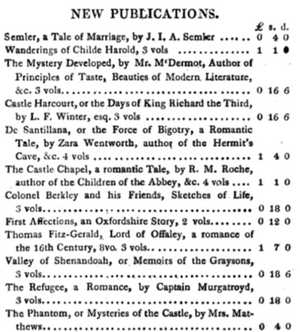 This post is yet another entry in the series clearing up the
tangled attribution
chain of aspiring authoress
Eliza Kirkham Mathews
(EKM) who died in 1802. 23 years after her death, London publisher Oddy & Co. issued an inexpensive one-volume novel titled The Phantom, or, Mysteries of the Castle, “by the late Mrs. Mathews, of the Theatres Royal, York and Hull." The story was offered for a mere four shillings--you can compare some other prices on their "new publications" list at right.
This post is yet another entry in the series clearing up the
tangled attribution
chain of aspiring authoress
Eliza Kirkham Mathews
(EKM) who died in 1802. 23 years after her death, London publisher Oddy & Co. issued an inexpensive one-volume novel titled The Phantom, or, Mysteries of the Castle, “by the late Mrs. Mathews, of the Theatres Royal, York and Hull." The story was offered for a mere four shillings--you can compare some other prices on their "new publications" list at right.James Burmester, an antiquarian book expert, pointed out that this London edition appears to be a re-issue of an earlier book that never made it onto any publication lists. Although the London publishers are on the title page, a publisher based in Hull has his imprint on the back of the title page and at the end. And Hull is where EKM lived with her aspiring actor husband Charles Mathews before they moved to York.
But what about this business of being of the Theatres Royal [in] York and Hull? It's Charles Mathews' second wife who was the actress, not EKM. But Anne Jackson Mathews --herself a published authoress--was alive when The Phantom came out; she was not "the late" Mrs. Mathews.
In Charles Mathews' memoir, there is no mention of EKM ever treading the boards--can she be described as being "of the Theatres Royal, York and Hull"? My research has turned up the fact that EKM did take to the stage, once in York and once in Hull, on her husband's "benefit nights." (Those are special performances when the profits from the night go to the featured performer.) So, while it might be an exaggeration, EKM could technically be described as being of the Theatres Royal of York and Hull.
This declaration jazzed up the title page of The Phantom and made the connection to the by-then-famous Charles Mathews clear to the reading public. More about EKM's theatrical career another time. Now, on to the novel itself... In previous posts, I discussed the characteristics of EKM's writing--characteristics that she shared with dozens if not hundreds of other writers, such as rapturous appreciation for scenery, moral didacticism, a heavy reliance on metaphorical phrases like "tear of sympathy" and "balm of consolation," narrative interjections and forewarnings, and so on. So instead, let's meet our (standard) characters of this gothic thriller.
 We begin with our bad guy
We begin with our bad guyOur tale is set in medieval times. Mortimer Mordaunt, the Earl of some random castle somewhere in England. “The earl’s person was handsome and majestic, yet the deep furrows of care were imprinted on his brow. An air of conscious superiority marked his every action, while beneath the specious mask of politeness, he endeavoured to conceal an haughty, vindictive, and imperious spirit.”
“In pursuit of a favorite scheme his mind was strong and inventive. Religion he contemned as the work of priestcraft, and the resource of weak and enthusiastic minds.” (Here we see how people used the word “enthusiastic” in those days to signify over-the-top and irrational religious devotion.)
The earl is the guardian of the beautiful Agatha, whose parentage is a mystery. She has been raised in a nearby convent.
The earl knows he should leave Agatha in the convent and encourage her to take her vows, but “her loveliness continually disarmed him of those suggestions of prudence.”
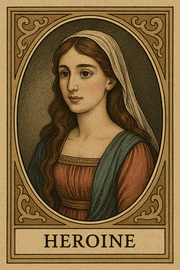 The lovely Agatha
The lovely AgathaOur heroine checks all the boxes. She has “dark and expressive eyes" and a "luxuriance of bright amber hair” and "“a bosom unsullied as the mountain snow.” She is “unaccustomed to the gaudy scenes of life, and... Agatha breathed not a wish beyond the sanctuary which had sheltered her infant years, nor sighed for other society than those friends who had cherished the seeds of virtue in her mind, and stored it with useful and elegant instruction.”
Agatha is brought from the convent to the castle--and of course she is enraptured by the scenery along the way: “the castle, the surrounding country, the hoarse murmurs of the river, and the melodious songs of the warblers, all had power to cheer and enliven the heart of the innocent traveller. Her mind, pure and unsullied from baneful passions, received with enthusiastic rapture, the sentiments which scenes like these engender in the heart consecrated to virtue. Happy, thrice happy state of purity!”
But she is very uneasy to take up residence with the Earl Mowbray, who clearly, ahem, admires her. Agatha tells the neighbourhood religious hermit of her troubles, “she saw the tear of commiseration gather in his eye, then burst from its bounds, and stray to his venerable beard. Affected by his tender sympathy, she pressed the extended hand of her worthy preceptor to her ruby lips, and with winning softness wiped away the tear of feeling.” The castle is haunted by a phantom who shows up to give Agatha some timely advice. “’Fear not, my child,’ said the phantom, ‘I come to warn you of impending dangers, to strengthen, not to terrify. Mowbray speeds his way to the castle, beware of his evil machinations, avoid the murderer, the murderer of thy mother!’ ‘Gracious God!’ exclaimed Agatha, ‘my mother’s venerated name; tell me, celestial being, in pity tell me, who was my mother?’ ‘Time,’ replied the phantom, ‘and holy angels will withdraw the veil of mystery, adieu!’”
 Original frontispiece The threat
Original frontispiece The threatThe danger, it becomes clear, is the lascivious propositions of Agatha's evil guardian. “[A] glow of virtuous indignation dyed her cheeks as she exclaimed, 'leave me, my lord, nor even dare again to insult me with proposals which my soul shrinks from with disdain!'
'Haughty girl,' replied he earl, 'do not provoke my vengeance, remember thou art in my power, tremble therefore, and be submissive.'
'Never! My heart scorns fear and submission, let the guilty tremble, and bow their heads to the dust, I am innocent!'
'You will repeat of this', said the earl, and hastened from the chamber."
The earl refrains from forcing himself on his niece and decides instead he had better have her killed--you'll find this same plot point in Ann Radcliffe's The Romance of the Forest. Just as with Radcliffe, it turns out the evil Earl is a usurper who has deprived his older brother of his birthright.
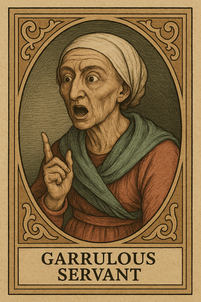 One of the earl's house guests, the handsome Adolphus De Burney, falls in love with Agatha, so he helps her escape through a secret tunnel to the home of the neighborhood hermit. Then he escorts her to a more distant convent, in the hopes that the Earl can't find her there. But he has to set out for the Crusades, so the lovers (I mean that in a romantic sense) must part.
One of the earl's house guests, the handsome Adolphus De Burney, falls in love with Agatha, so he helps her escape through a secret tunnel to the home of the neighborhood hermit. Then he escorts her to a more distant convent, in the hopes that the Earl can't find her there. But he has to set out for the Crusades, so the lovers (I mean that in a romantic sense) must part. The evil Earl recaptures Agatha. He locks her up for the time being in his spare castle, overseen by “the loquacious [servant] Debora.” Debora is thrown into a flurry when her master arrives, “ye blessed saints defend us… here’s the earl arrived, and with him such a train of servants; well, well, I must hasten down to receive him, though I never was worse prepared to see his lordship; the castle, as I may say, is all at sixes and sevens… Lord bless us, was ever the like before?”
In contrast, the female servant in Romance of the Forest isn't loquacious (in fact she has no dialogue at all). She isn't used as a confidante for the heroine or a device for exposition, either.
At any rate, Agatha manages to escape. Two mysterious female pilgrims show up and tell Agatha to come with them. Agatha is escorted back to St. Mary's convent.
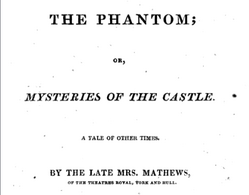 Title page of "The Phantom" (detail)
Scooby Doo revelation
Title page of "The Phantom" (detail)
Scooby Doo revelation
We learn that sadly, the hero Adolphus has perished in a shipwreck so Agatha decides to stay at the convent and become a nun. Here is when EKM lets us know that the supernatural Phantom is not a phantom after al! It's Matilda, Agatha's mother (also one of the two mysterious female pilgrims). It might comfort Agatha in her heartbreak to know that her mother is alive, but nah... “Matilda had formed a wish of discovering herself to her daughter, but for the present determined to banish the pleasing idea, fearing it would draw her mind from her religious duties.” Makes sense. And at any rate, there is only one proper time for making astounding revelations, and that is of course, the moment when Agatha is about to take the veil.
Our hero De Burney arrives in the nick of time! He's not dead after all! Our heroine faints, and wakes up to see her father, also returned from the dead, hanging over her.
"At that instant a female rushed into the room, and flinging back her veil, discovered to the enraptured eyes of [dad] Mowbray--Matilda! His adored and long lamented wife! A scene ensued so unexpectedly tender that no being, save a celestial habitant of heaven, can pourtray it. The mind, possessed of sensibility, may imagine what words are inadequate to express."
It turns out that Agatha's father also turned hermit, i.e., he is a man who, on being told his wife and child had died while he was away at war, abandoned his title and responsibilities, and left his dependents and tenants to the mercies of his evil younger brother. He was therefore unaware that his wife, fearing for her virtue and life, had run away from the castle and was living in a cave with her faithful female attendant. As we've seen she occasionally haunted the castle to reproach the evil usurper and to falsely tell Agatha that he was "the murderer of thy mother". But she didn't rescue her daughter by taking her back through the secret tunnel to the same cave. Just... hanging out in a cave for years on end while dad was hanging out in his hermitage near that other castle. But let's not bicker and argue about whose actions made whose life miserable.
When the family is unexpectedly reunited and the false earl exposed as an usurper, Daddy Earl instantly forgives his wicked younger brother to demonstrate his Christian principles, and phantom/wife/mother calls on the heroine (whose real name is Victoria) to do the same: "'[C]onfirm that pardon which your noble sire has awarded to his brother.' 'May heaven bless me,' exclaimed Victoria, in a solemn tone of voice, as she bent over the unhappy Mortimer “as I forgive him.”
It is understood that evil uncle Mortimer will end his days in a monastery. Victoria and Adolphus are married and mom and dad renew their vows. Curtain.
 Note the mark of the original Hull publisher and the obsolete use of the long "s". Plots and sub-plots
Note the mark of the original Hull publisher and the obsolete use of the long "s". Plots and sub-plotsThe main narrative I've described is abruptly interrupted three times for the dramatic backstories of three unlucky couples whose romances were thwarted. Inset narratives were exceedingly common in novels of this era--Austen used inset narratives, but more skillfully, as for example, when Colonel Brandon tells his story in Sense & Sensibility. Brandon's story is integrated into the plot. EKM's three sub-plots arguably serve as a tragic contrast to the main plot, and although I haven't read a lot of gothic novels, I suppose it was a common trope of the genre to include several tragic sub-plots involving separated lovers, as for example in Glenmore Abbey (1805) . These sub-plots also padded out the story, and The Phantom, already a short novel, would be much shorter without them. At a time when novelists could spin out a dilemma for chapter after chapter, EKM was quite terse. Here is her entire description of Adolphus' campaign in the Holy Land, something that would have taken--what, more than two years?: "Soon as the crusaders were landed on the shores of Palestine, they had repeated skirmishes, in which Prince Edward bore the palm of victory. In one of these skirmishes, Adolphus de Burney received a wound in his side, which had nearly proved fatal, and he was borne off the field of battle on the bucklers of his soldiers....[he convalesces and] the idea of again beholding his beloved Agatha enlivened his heart; joy sparkled in his eyes, and the roseate glow of hope animated his cheeks. The voyage was short and pleasant; they were now within sight of Albion’s white cliffs, and the sailors hailed with rapturous shouts their native shore.”
The Phantom reads as the production of a teenager who is a big fan of Gothic novels. There's nothing wrong with that--its how many writers learn their craft, by imitating others. I really need to read Percy Bysshe Shelley's two gothic novels that he published when he was a teenager sometime. There is no mention of The Phantom in Anne Jackson Mathews' memoir of her husband but she does say "no publisher thought [EKM's writings] worth much more than the cost of printing." I'm guessing EKM paid to have the novel printed (just as Austen did with Sense & Sensibility) but the gamble did not pay off in Hull and she was left with a lot unsold novels. A foreword that is also a disclaimer
By the 1820s, the craze for gothic novels had passed, although the genre still had its fans, of course. I don't know who arranged for the 1825 re-issue of The Phantom. Presumably it was either Charles Mathews, in fond memory of his first wife, or it was Anne Jackson Mathews, who saw a way of disposing of a pile of remaindered books. Who wrote this deprecatory foreword? Was it Anne Jackson, or the publisher?: “The following pages will not attract admiration for the brilliancy of the thoughts, the elegance of the diction, or the strict originality of the character—but the sensible and feeling heart will be interested in the fate of Agatha, who, amidst misfortunes of the most trying nature, preserves the dignity of a virtuous mind, and struggles to bear with calmness and resignation, the unmerited persecutions of [the villain who commits] deeds at which humanity shudders, and pity shrinks from, aghast and trembling.”

For more about the Gothic novels of this era, Ann B. Tracy's The Gothic Novel 1790-1830: Plot Summaries and Index to Motifs is a valuable guide, with an index like no other, with entries for "passage, subterranean," and "relative, lost, discovery of" and "veil-taking, disrupted."
For more about the way writers of this era used words like "serious" and "enthusiast" to refer to religion, I recommend Brenda Cox's book, Fashionable Goodness, Christianity in Jane Austen's England.
 Previous post: West Indians in children's books
Previous post: West Indians in children's books
Published on October 14, 2025 00:00
September 30, 2025
CMP#229 An influential children's book
 This month marks the fifth anniversary of my blog, which explores social attitudes in Jane Austen's time, discusses her novels, reviews forgotten 18th century novels, and throws some occasional shade at the modern academy. The introductory post is here. My "six simple questions for academics" post is here. Spoilers abound in my discussion of these forgotten novels, and I discuss 18th-century attitudes which I do not necessarily endorse. CMP#229 Three children's books--one plot. Also, who influenced whom?
This month marks the fifth anniversary of my blog, which explores social attitudes in Jane Austen's time, discusses her novels, reviews forgotten 18th century novels, and throws some occasional shade at the modern academy. The introductory post is here. My "six simple questions for academics" post is here. Spoilers abound in my discussion of these forgotten novels, and I discuss 18th-century attitudes which I do not necessarily endorse. CMP#229 Three children's books--one plot. Also, who influenced whom?
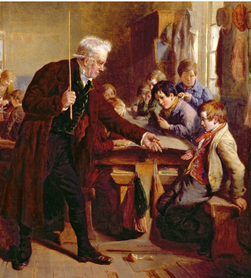 The Village School, William Henry Knight, detail In
my previous post
, I looked at two books for children, published by two different authors, both featuring a spoiled young West Indian heiress coming to England and correcting her behaviour after receiving judicious instruction from her host family. These two books are examples of a then-popular genre for children's books, which combined morally improving narratives with inset fables, scientific discourses, dialogue, and history lectures. As I mentioned, a book by Thomas Day, Sandford and Merton, was an outstandingly popular exemplar of this genre.
The Village School, William Henry Knight, detail In
my previous post
, I looked at two books for children, published by two different authors, both featuring a spoiled young West Indian heiress coming to England and correcting her behaviour after receiving judicious instruction from her host family. These two books are examples of a then-popular genre for children's books, which combined morally improving narratives with inset fables, scientific discourses, dialogue, and history lectures. As I mentioned, a book by Thomas Day, Sandford and Merton, was an outstandingly popular exemplar of this genre. According to scholar Peter Rowland, Sandford and Merton was published in three volumes in 1783, 1786 and 1789 and quickly gained such popularity that “the next instalment was eagerly and impatiently awaited by a legion of small readers.” The book was reprinted for over a hundred years but it is now largely forgotten.
As Rowland describes the premise, "rebellious Tommy Merton, the spoilt son of a wealthy plantation owner from Jamaica, and his friend Harry Sandford, the poor but worthy son of a local farmer, are patiently educated by the Reverend Mr. Barlow... Master Tommy is brought, by precept and self-discovery, to see the error of this ways. A host of interpolated stories [are included], providing introductions to ancient history, astronomy, biology, science, exploration and geography” to which I would add the book includes moral fables in which kindness is always rewarded and cruelty is punished.
Rowland points out that Thomas Day based Sandford and Merton on the educational philosophies of Jean-Jacques Rousseau; for example, Tommy’s tutor starts teaching him to read only after Tommy himself requests to be taught. Letting the child take the lead seems rather peculiar when we consider that it was routine to beat an education into boys at this time. Reverend Barlow is nothing like the typical switch-wielding schoolmaster, and many school boys must have wished they could have been educated along the lines depicted in Sandford and Merton.
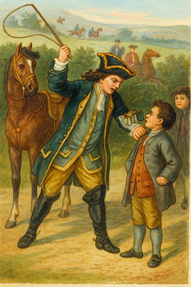 "And which way is she gone?" "Sir, I don't choose to tell you." Egalitarian message
"And which way is she gone?" "Sir, I don't choose to tell you." Egalitarian messageSandford and Merton also features great sympathy for the poor along with a heaping helping of contempt for the upper classes. In the scene depicted at left, Harry refuses to tell a haughty local squire which way the hare he was hunting had run, and takes a whipping for it.
When Tommy's father asks Rev. Barlow to undertake his education, Mr. Barlow replies bluntly: “Gentlemen in your situation of life are accustomed to divide the world into two general classes; those who are persons of fashion, and those who are not… their manners, their prejudices, their very vices, must be inculcated upon the minds of children… the second [class of mankind]… are represented as being only objects of contempt and disgust, and scarcely worthy to be put on a footing with the very beasts that contribute to the pleasure and convenience of their superiors.”
Tommy’s father protests that although he and his wife “wished their son to have the manners of a man of fashion, they thought his morals and religion of infinitely more consequence.”
“If you think so, sir," said Mr. Barlow, “it is more than a noble lord did, whose written opinions are now considered as the oracles of polite life.” Mr. Barlow is referring, I think, to Lord Chesterfield and his famous letters of advice to his son.
The message throughout is that "gentlemen" do not deserve any special deference, compared to honest yeomen. Once Tommy overcomes his aversion to doing any manual labour, he and Harry try to make a fire with flint, build a wattle-and-daub house through trial and error, and start their own orchard and vegetable garden.
Generations of parents approved of Sandford and Merton for its homilies about living a simple and virtuous life and rejecting materialism. Says Rowland, “parents everywhere felt it their bounden duty to ensure that their children read it.”
 The runaway financial success of Sandford and Merton was an invitation to other authors to follow suit with imitations and variations. How about a spoiled girl instead of a spoiled boy, like the two books discussed in my
previous post?
How about a nice West Indian sent to live with some spoiled English kids? A prolific author known to us only as “A. Selwyn” reversed the personalities in this way. In The Young Creoles (1825), the gentle and timid Francis and Blanche arrive in England as orphans and are taken into their uncle’s home. Their unruly cousins lure Francis’ youthful black servant Juba into the back yard and pelt him with snowballs. Francis protests on Juba’s behalf, but his cousins sneer: “if we had a little fun with seeing blackey skipping in the snow, I can’t see what concern it is of your’s; particularly, as he do’n’t belong to you, and a’n’t your slave the moment he sets his foot on English ground.”
The runaway financial success of Sandford and Merton was an invitation to other authors to follow suit with imitations and variations. How about a spoiled girl instead of a spoiled boy, like the two books discussed in my
previous post?
How about a nice West Indian sent to live with some spoiled English kids? A prolific author known to us only as “A. Selwyn” reversed the personalities in this way. In The Young Creoles (1825), the gentle and timid Francis and Blanche arrive in England as orphans and are taken into their uncle’s home. Their unruly cousins lure Francis’ youthful black servant Juba into the back yard and pelt him with snowballs. Francis protests on Juba’s behalf, but his cousins sneer: “if we had a little fun with seeing blackey skipping in the snow, I can’t see what concern it is of your’s; particularly, as he do’n’t belong to you, and a’n’t your slave the moment he sets his foot on English ground.” “His not being my slave,’ said Francis, ‘don’t make him your’s’; for I don’t think the poor fellow would wish to change masters.”
Francis and Blanche are portrayed as weak and enervated, owing to growing up in a tropical climate. This is a common trope, although the heroine of The Woman of Colour is an exception in that regard. This stereotype turns our thoughts again to the mystery of Miss Lambe, the "chilly and tender" "half-mulatto" who was to play a role in Jane Austen’s unfinished last novel Sanditon. Was she going to be fretful and entitled like Matilda in The Barbadoes Girl, or gentle and easily imposed upon, like Blanche?
 Little Fanny is intimidated upon her arrival at Mansfield Park Did Austen influence Hofland?
Little Fanny is intimidated upon her arrival at Mansfield Park Did Austen influence Hofland? A well-known Austen scholar has recently surmised that The Barbadoes Girl was inspired by Mansfield Park; that is, she suggests that Barbara Hofland inverted the story of Fanny Price, a virtuous waif who goes to live with her haughty cousins, to create her tale about a haughty orphan who goes to live with her virtuous cousins. Further, since Mansfield Park’s anti-slavery message is muted (to say the least), she also suggested that Barbara Hofland decided to amplify the abolitionist message in The Barbadoes Girl as a reaction to Austen’s reticence in Mansfield Park.
Since there are so many examples of the displaced waif in the literature of this time, I don’t see a compelling case for drawing a direct line from Austen’s novel to Hofland’s children’s book. And since Eliza Kirkham Mathews used the same premise when she wrote The Young West Indian before Mansfield Park was published in 1814, we can be certain that her iteration was not inspired by Austen’s novel. Fanny’s question about the slave trade could not have inspired EKM to add a scene where Miss Mountford beat her maid, and by extension I doubt Austen had anything to do with Matilda throwing a glass of beer in her servant’s face in The Barbadoes Girl.
We can find many examples of novels written before and during Austen's day which condemned slavery more emphatically and more explicitly than Austen. There is no evidence that Austen's omission of a strong anti-slavery message impelled anyone else to include one.
Furthermore, it's surprising how few people have grappled with the fact that, at the end of Persuasion, the narrator commends Captain Wentworth for helping the widowed Mrs. Smith regain her lost income from the West Indies, without a hint of disapproval that the money is blood-soaked: Mrs. Smith's "recent good offices by Anne had been enough in themselves, and their marriage, instead of depriving her of one friend, secured her two. She was their earliest visitor in their settled life; and Captain Wentworth, by putting her in the way of recovering her husband’s property in the West Indies, by writing for her, acting for her, and seeing her through all the petty difficulties of the case with the activity and exertion of a fearless man and a determined friend, fully requited the services which she had rendered, or ever meant to render, to his wife."
I am not saying that we should assume Austen was indifferent about slavery. In fact, I am willing to stipulate that she opposed slavery, just as her brothers did. But she did not choose to make it a central feature of her novels.
 About Thomas Day (1748-1789)
About Thomas Day (1748-1789) Thomas Day was a wealthy and childless British eccentric who somehow wrote an enduring children's classic. His biographer Wendy Moore says Sandford and Merton "was reprinted 140 times by 1870" and "launched an entire new genre in adventure books for boys," I should think that even Louisa May Alcott's Little Women and Little Men owes something to Sandford and Merton. Day himself conducted an extraordinary experiment in education: he selected two pretty girls from the Foundling Home with a view to training them up to be an ideal wife (he intended to marry the "winner"). Moore's book, How to Create the Perfect Wife is the compelling story of Day and his friends--I had no idea that Maria Edgeworth's father was such an eccentric. Really, this story is stranger than fiction.
Boulukos, George. The Grateful Slave : The Emergence of Race in Eighteenth-Century British and American Culture. Cambridge University Press, 2008.
Rowland, Peter. “Unwelcome Company: Thumbs Down for Sandford and Merton.” The Wildean : Journal of the Oscar Wilde Society, no. 38, 2011, pp. 44–53.
Thank you to the Special Collection librarians at the University of Iowa. Previous post: Two books, one plot premise
Published on September 30, 2025 11:28
September 29, 2025
CMP#228 Two children's books, one plot
 Clutching My Pearls is my ongoing blog series about my take on Jane Austen’s beliefs and ideas, as based on her novels. Folks today who love Jane Austen are eager to find ways to acquit her of being a woman of the long 18th century. Click here for the first post in the series. CMP#228 Two books for children, one plot
Clutching My Pearls is my ongoing blog series about my take on Jane Austen’s beliefs and ideas, as based on her novels. Folks today who love Jane Austen are eager to find ways to acquit her of being a woman of the long 18th century. Click here for the first post in the series. CMP#228 Two books for children, one plot
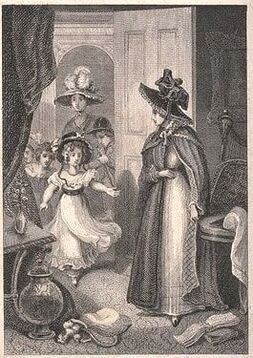 Meeting the governess I recently received a digital copy of a rare and obscure children’s book by
Eliza Kirkham Mathews
(EKM), generously supplied to me by the University of Iowa. Now that I have a copy of The West Indian, I think I have succeeded in tracking down all of EKM’s books, so I can put together a definitive list of attributions and clear up some mistaken attributions.
Meeting the governess I recently received a digital copy of a rare and obscure children’s book by
Eliza Kirkham Mathews
(EKM), generously supplied to me by the University of Iowa. Now that I have a copy of The West Indian, I think I have succeeded in tracking down all of EKM’s books, so I can put together a definitive list of attributions and clear up some mistaken attributions.The West Indian was published in 1821 in Derby and attributed to “Mrs. C. Mathews,” 19 years after EKM's death. The most logical explanation for the appearance of this title after EKM's death in 1802 is that her husband Charles sought out publishers for the manuscripts Eliza left behind--even though he and his second wife had no great opinion of her writing abilities. The second Mrs. Mathews was also an author who compiled and wrote her husband's memoir after his death. Her effusive, breezy style is very different from EKM's. Anne Jackson Mathews said of her predecessor: “She knew nothing of society or of the world. Her reading had been slender, and confined to the generally mawkish style of the novels of that day. From them she gave faint impressions of nature; and no publisher thought them worth much more than the cost of printing. Disappointment followed disappointment.”
I like to think Charles Mathews worked to find publishers for EKM’s manuscripts out of affection and respect for her, knowing that it would have been something that she wanted. An early composition?
The West Indian appears to be an earlier draft of Ellinor, or the Young Governess which was published in 1802). In both stories, young Ellinor Montague is orphaned and needs to support her little sister Sophy. Just like the other children’s books I have reviewed here, both tales contain educational discourses on morality, history, botany and so forth, held together with a narrative in which the governess awakens the children’s love for learning and improves their characters. Although both books follow this formula and have the same basic premise, the details are different. In The Young West Indian, the Somerville children learn about castles and Stonehenge and ants. In Ellinor, the Selby children learn about ducks and the sources of rivers.
Ellinor is written with third-person narration in a more highly wrought sentimental style, while The Young West Indian, written in epistolary style, has more of Georgian restraint and periodicity about it. I think it must be an earlier, as opposed to a later, composition. Here Ellinor describes her introduction to her pupils in a letter to her sister: “My dear children,” said Mrs. Somerville, leading me into the room in which [the] Miss Somervilles and Miss Mountford were amusing themselves, “this is the young lady who has kindly undertaken the cultivation of your minds; pay to her that deference and respect which she so highly deserves; treasure her instructions, for they will lead you to virtue, and ultimately to happiness: be attentive to her admonitions, obedient to her commands, and submissive to those punishments, which for your advantage, she may sometimes think it proper to inflict.”
 Untangling Misattributions
Untangling MisattributionsI was convinced that EKM is the author of Ellinor, or the Young Governess because it includes a poetic tribute to her deceased cousins, which also appeared in her posthumous book of poetry. As well, of course, Ellinor’s desperate situation and fall from gentility after the death of her parents, parallels EKM’s own life. EKM did not use her own poetry in The Young West Indian. Instead, the children recite poems by Parnell and Thomson. But she does describe Kent’s Hole, a cavern on the coast of her native Devonshire.
Miss Mountford, a ward of the Somerville family, is the spoiled West Indian of the title. As Mrs. Somervile explains to Ellinor: “'Poor child! Early deprived of her mother, she has been left to pursue her own silly inclinations, till this blameable indulgence has destroyed the equanimity of her disposition, and rendered her haughty, impetuous, and almost uncontrollable.’ I have been introduced to my pupils, and find them as Mrs. Somerville described. Miss Mountford, the West-Indian, is indeed… very naughty and very impetuous.”
Miss Mountford treats her servant, a pidgin-speaking black girl, with cruelty.
“Do as I command you, instantly, or I’ll murder you!”
“Den me go to great good Being, Missy; but if me tell lie me not able to pray to him.”
“Dost think, you black ugly wretch,” replied Miss Mountford, “you’ll ever go to heaven? Look, how white my skin is compared to yours!”
“Ah, Missy, but me white heart, and dat’s better den white skin!”
“’Insolent creature, take that, and that,’ striking her as she spoke, with the utmost violence…
I entered the room [and] caught her arm and prevented this unjust action….
"‘She is only a negro,’ returned Miss Mountford, ‘and negroes one may be allowed to beat.”
“And why? [Ellinor challenges her] Are they not equally alive to feeling with yourself?...The same Power who created you created them; like you they are formed, and like you have an immortal soul: in what then do they differ? In the colour of their skin?”
Ellinor writes to her sister: “How poor, contemptible and mean appears the immensely rich Miss Mountford, when compared with the honest and ingenuous Zelia; while we turn with disgust from this rich and powerful West-Indian, we involuntarily pay the homage of admiration to a poor negro, the innocent and unsophisticated daughter of Nature!
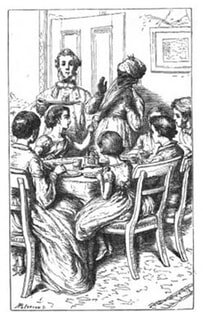 Fortunately, thanks to Ellinor’s tutelage, Miss Mountford (we never discover her first name) repents and reforms, especially after she experiences the pleasure of bestowing charity upon some unfortunate poor village girls. As well, Ellinor’s pupils learn to despise the empty pomp and vanity of the fashionable world after visiting with the snobbish Miss Harrington. The story ends rather abruptly and we are given no information about what happens to the Miss Somervilles or Miss Mountford or with Ellinor and her sister in the future.
Fortunately, thanks to Ellinor’s tutelage, Miss Mountford (we never discover her first name) repents and reforms, especially after she experiences the pleasure of bestowing charity upon some unfortunate poor village girls. As well, Ellinor’s pupils learn to despise the empty pomp and vanity of the fashionable world after visiting with the snobbish Miss Harrington. The story ends rather abruptly and we are given no information about what happens to the Miss Somervilles or Miss Mountford or with Ellinor and her sister in the future.The Barbadoes Girl
Since this book must have been written before EKM died in 1802, its composition predates another book about a spoiled West Indian heiress who is sent to live with a family in England, namely, The Barbadoes Girl (1816) by Barbara Hofland, which I reviewed here.
In that tale, the bratty Matilda Hanson throws a glass of beer into her servant's face while sitting at the dinner table, to the shock of her hosts. Zebby speaks up in her defence:
“Poor Zebby, courtesying, said, ‘Sir, me hopes you will have much pity on Missy—she was spoily all her life, by poor massa—her mamma good, very good; and when Missy pinch Zebby, and pricky with pin, then good missis she be angry; but massa say only—‘Poo! Poo! She be child—naughty tricks wear off in time.’”
So after reading The Young West Indian, I was really scratching my head—is it just a coincidence that EKM came up with a plot about a spoiled West Indian girl who is abusive to her servant years before Barbara Hofland wrote a best-seller about a spoiled West Indian girl who is abusive to her servant? Hofland could not have copied EKM’s story since it wasn’t published until after The Barbadoes Girl, even though EKM’s version was written before. Was EKM just unfortunate in that she had the idea first, but her manuscript never saw the light of day until after her death? The original story
Well, I stumbled across a plausible explanation for how both authors could have written two very similar stories—both of these novels were probably written in emulation of a tremendously successful but now forgotten children’s book: The History of Sandford and Merton, first published in 1783. Sandford and Merton is the GOAT (as the kids say) version of a spoiled West Indian boy who comes to live in England and is reformed by wise precept and a bit of deserved suffering.
Here is author Thomas Day’s description of the protagonist: “Tommy Merton, who, at the time he came from Jamaica, was only six years old, was naturally a very good-tempered boy, but unfortunately had been spoiled by too much indulgence. While he lived in Jamaica, he had several black servants to wait upon him, who were forbidden upon any account to contradict him. If he walked, there always went two negroes with him; one of whom carried a large umbrella to keep the sun from him, and the other was to carry him in his arms whenever he was tired. Besides this, he was always dressed in silk or laced clothes, and had a fine gilded carriage, which was borne upon men's shoulders, in which he made visits to his play-fellows. His mother was so excessively fond of him that she gave him everything he cried for, and would never let him learn to read because he complained that it made his head ache.”
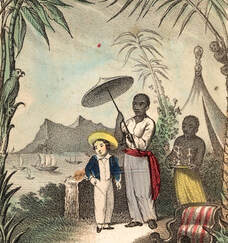 Day used the familiar formula for an instructive children’s books; that is, narrative interspersed with improving discourses, but his narration is livelier, more detailed, and features a plot with actual character arcs.
Day used the familiar formula for an instructive children’s books; that is, narrative interspersed with improving discourses, but his narration is livelier, more detailed, and features a plot with actual character arcs. Some of the educational material is woven more smoothly into tale. The boys’ tutor challenges Tommy with Socratic dialogues: "And pray, young man," said Mr Barlow, "how came these people to be slaves?"
Tommy.—Because my father bought them with his money.
Mr Barlow.—So then people that are bought with money are slaves, are they?
T.—Yes.
Mr B.—And those that buy them have a right to kick them, and beat them, and do as they please with them?
T.—Yes.
Mr B.—Then, if I was to take and sell you to Farmer Sandford, he would have a right to do what he pleased with you?
 By the conclusion of this dialogue, Tommy vows he will never “will use our black William ill; nor pinch him, nor kick him, as I used to do.”
By the conclusion of this dialogue, Tommy vows he will never “will use our black William ill; nor pinch him, nor kick him, as I used to do.”A black sailor appears at the climax of the tale to help rescue Tommy from a charging bull. Unlike the servants in EKM and Hofland’s stories, he speaks in correct English, not pidgin: “Is a black horse thought to be inferior to a white one in speed, in strength, or courage? Is a white cow thought to give more milk, or a white dog to have a more acute scent in pursuing the game? On the contrary, I have generally found, in almost every country, that a pale colour in animals is considered as a mark of weakness and inferiority. Why then should a certain race of men imagine themselves superior to the rest, for the very circumstance they despise in other animals?”
More about Sandford and Merton in the next post. And who knows, I might come across more forgotten books with this type of plot in the future. Also, is there a connection to Jane Austen in all this? An 1823 short story by Mrs. Blackford, The Young West Indian, features the young son of an Army captain who behaves heroically when misfortune throws him and his baby sister into the power of an unscrupulous servant. Little William is not a typical sickly, spoiled Creole child as portrayed in the stories discussed here. The story mentions that British parents typically sent their children to be educated in England and that the heat and the ever-present fear of yellow fever made parents anxious for their children’s health.
These fictional portrayals of West Indian children appear drawn from real-life observations about the children of English settlers. According to scholar Chloe Northrop, “European observers noted the overindulgence exhibited in the progeny of the wealthy Caribbean elite, stemming from both their parents and others responsible for their upbringing… According to these narratives, [enslaved people working as nannies and caregivers] irrevocably spoiled the character of the young white inhabitants.
"Furthermore, at a young age, these children became accustomed to seeing violence against black slaves, including maimings and whippings.” Northrop, Chloe. Fashioning Society in Eighteenth-Century British Jamaica. United Kingdom, Taylor & Francis, 2024.
Rowland, Peter. “Unwelcome Company: Thumbs Down for Sandford and Merton.” The Wildean : Journal of the Oscar Wilde Society, no. 38, 2011, pp. 44–53.
Thank you to the Special Collection librarians at the University of Iowa. Previous post: Regency-era children's lit Next post: Three children's books, one plot
Published on September 29, 2025 00:00
September 24, 2025
CMP#227 Regency-era children's literature
 “Indeed, Ma’am,” said Lionel, “I may venture to answer for all, that we had rather go to bed supperless, on condition of passing as many more agreeable hours as we have done this evening.”
“Indeed, Ma’am,” said Lionel, “I may venture to answer for all, that we had rather go to bed supperless, on condition of passing as many more agreeable hours as we have done this evening.”--child begs for extra educational instruction in Evenings Rationally Employed, or Moral and Entertaining Incentives to Virtue and Improvement, by W. Helme (1803) CMP#227 Outspoken Regency-era children's literature
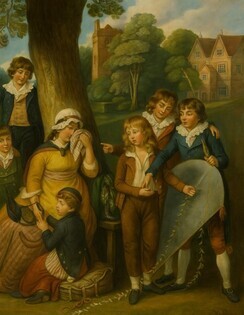 The soldier's widow; or, school boys' collection, British Museum (detail, colorized by Chatgpt) On my trip to England this past summer, I had the privilege of spending a morning researching some old books at the Weston library at Oxford—books which, so far as I know, are unique, in that Oxford is the only library in the world that has a copy. These particular books are not Gutenberg bibles by any means—they are forgotten publications of the Regency era, the kind of books offered in subscription libraries or at bookstores for the average reading public. There is a quiet pleasure in stepping into the reading room at an Oxford library and being entrusted with a book more than two hundred years old that has been slumbering in an archive for who knows how long, and being allowed to open and read it.
The soldier's widow; or, school boys' collection, British Museum (detail, colorized by Chatgpt) On my trip to England this past summer, I had the privilege of spending a morning researching some old books at the Weston library at Oxford—books which, so far as I know, are unique, in that Oxford is the only library in the world that has a copy. These particular books are not Gutenberg bibles by any means—they are forgotten publications of the Regency era, the kind of books offered in subscription libraries or at bookstores for the average reading public. There is a quiet pleasure in stepping into the reading room at an Oxford library and being entrusted with a book more than two hundred years old that has been slumbering in an archive for who knows how long, and being allowed to open and read it.One of the books I examined was a book for children written by William Helme, the schoolteacher husband of the hard-working author Elizabeth Helme . His book is a typical example of the children’s literature of the day, and that’s why I want to talk about it—because it is so typical. It is a compilation of material plagiarized (as we would call it today) from authors of natural history, strung together with a narrative about some children and the wise adult who instructs them and judiciously corrects their faults. Other examples of children’s literature of this type discussed in this blog can be found here and also here. Authors of this type of book did not hold back on their opinions about social issues, as we will see.
 Botanical print, British Museum Narration and plagiarism
Botanical print, British Museum Narration and plagiarismIn this brisk-moving narrative, Mr. Melville, an educated gentleman, has fallen on hard times and takes in some pupils. Luckily for him, his students are eager to be instructed, to put it mildly, and are easily reformed out of their faults. For example, Mr. Melville takes in a crippled child who had been bullied in his previous school. The other kids tease him. As punishment, Mr. Melville doesn’t let them go to a neighbour’s birthday party, but when they instantly apologize, he relents. He awakens their charitable impulses by helping a poor widow and her children, and the book ends with a strong denunciation of slavery.
I’m rather intrigued by the freedom with which children’s books were cobbled together with plagiarized material. It’s easy to spot the plagiarized bits because they always start right after one of the children says something like, “Pray, madam, tell us about the eider duck.” And the adult launches into a lecture about ducks, to which the children listen with rapt attention. In Evenings Rationally Employed, we have:
“Mr. Melville offered to instruct them about ants.
“Every tongue was immediately in motion, to express how highly they should deem themselves gratified by the recital… and Mr. Melville began as follows: 'The ants are a little people, united, like the bees, into a republic, which, if we may be allowed the expression, has its own peculiar laws and politics'” (etc.)
This same discourse about ants can be found in The Wonders of Nature and Art (1850); The Young Lady’s Introduction to Natural History (1766); and Zoography; or the Beauties of Nature displayed (1807); but originates in Spectacle de la Nature by the Abbe Le Pluche, first translated in 1743. While some authors acknowledge that their children's books were compiled “from the writings of the most eminent authors,” Helme does not. "Sable Brethren"
The climax of the book, if there can said to be a climax, is a strong denunciation of slavery, followed by an explanation that God’s ways are unknowable to man. There is also a story, no doubt borrowed from somewhere else, about two noble young blacks taken into slavery who commit suicide rather than submit to degradation. Mr. Melville’s neighbour, Mr. Jefferies, begins with a condemnation of the reconquest of Jerusalem in 1099 AD, blaming the Crusaders for barbaric slaughter. “[Shedding] the blood of upwards of seventy thousand Mahometans, as they spared neither age or sex, nor even infants at the breast. The rage of slaughter then ceased, and strange to tell, a religious frenzy succeeded! – The Christian conquerors, with hands stained with gore, marched over heaps of dead to the holy sepulchre, and chaunted anthems to the mild messenger of peace.”
“Tis strange indeed,” said Mr. Jefferies, “that the professors of a religion, should entitle any one to be esteemed a real member of it; though there are many of those in question, who will, if asked, gravely tell you, they firmly believe every scriptural text—Should you even enquire whether they suppose all men sprung from Adam, they would answer yes; and yet these motley and equivocal Christians, will not allow their sable brethren to be of the same species with themselves.”
“These are the beings whom, with the most barbarous oppression, we deprive of liberty, bow down with unrequired labour, and reward with cruel stripes—Poor heathen negroes, thy day of peace will come! –Blush, civilized European, blush; and when thou art sinking under the baneful poison of the yellow fever, remorse will, perhaps, though late, dictate to thy repentant soul—“'Tis by such means as these, Afric, that Providence doth avenge thee.''”
 Taking of Jerusalem by the Crusaders, Émile Signol (detail) (1847)
Taking of Jerusalem by the Crusaders, Émile Signol (detail) (1847) “Why does Providence permit the poor blacks to be so badly treated?” [one of the children asks].
“It is not for frail mortality to pry into the secret and hidden paths of unerring wisdom, —the most sublime act of human reason, is to submit and adore. --While man confines himself to things that are unveiled, he so far performs his duty; but he hath no right to scrutinize into the system by which he is governed.—His knowledge and strength are most judiciously limited by bounds suitable to his wants. The sum total of all human knowledge ought, therefore, to consist in making a prudent use of our Creator’s benevolence, in what he has vouchsafed to reveal, and in giving him the glory.”
The discourse here ceased for the evening, and the young gentlemen immediately retired to their apartments. THE END. This passage is yet another exhibit, though no more evidence is needed, to refute the idea that Mansfield Park is a bold but subversive statement against slavery and in fact was as far as Austen could go in her times in denouncing slavery. If a children’s book can call down death by yellow fever on slaveholders, then I think an unspecified question about the slave trade from Fanny Price, made after the slave trade was abolished, would not have made much of an impression on the readers of Austen’s time.
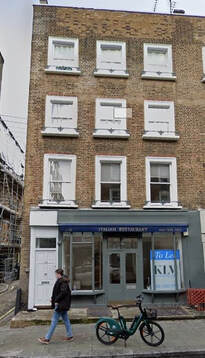 The Helmes lived for a time in this apartment building at Paddington Street in London. About William Helme (??-1822) and his wife Elizabeth (1753--1810)
The Helmes lived for a time in this apartment building at Paddington Street in London. About William Helme (??-1822) and his wife Elizabeth (1753--1810)Mr. Helme’s book received an approving review from The Literary Journal: “Several remarkable and entertaining facts in some branches of natural history, and a number of interesting events in the history of nations, are here related in a plain, easy, and natural style.” [I myself would describe Mr. Helme’s style as stiff and unimaginative, but whatever]. The important thing is, “The object of the authoress (for we believe it to be the production of a lady) appears to be to inspire young minds with a taste and desire for useful knowledge, and in the execution of this object we think she has been very successful. The morality is pure, and no dangerous principles are inculcated, to give a wrong bent to the minds of unwary youth. There is nothing in this book to hurt or offend (no small comparative merit) but much to instruct and amuse.”
The character of Mr. Melville appears to be a self-portrait. “Mr. Melville had, from an early period in life, lived in what is called the great world; for his family being respectable, and his fortune affluent, he was, of course, deemed sufficiently qualified to associate with those, whose only merit consisted in hereditary acquirements. In his journey through life, he had also attracted the notice of that judicious few, who wisely discriminate between mere superficials, and the more rare possession of good sense, humanity, and rectitude.” Jane Austen was never so open in taking a jab at the class system of England as is Mr. Helme when he describes how he fell out of genteel society:
Just as occurred to the Helmes in real life, a disastrous loan to a friend sunk Mr. Melville into poverty. “By such [a false friend] Mr. Melville was undone, and left at the age of forty, with barely two hundred a pounds a year, in lieu of as many thousands.”
Mr. Helme has been described as a schoolmaster, but I cannot find any advertisements for his school or seminary in the British Newspaper archive. I imagine therefore that he, like Mr. Melville, quietly took on students through personal referrals.
No copies appear to have survived of William Helme's 1794 novel, Henry Stukely, or the Effects of Dissipation, but the Corvey Collection in Germany has a copy of his 1801 novel, Mysterious Friendship. His 1788 novel Adventures of a Watch contains some social commentary and a bigoted (intended to be comic) portrayal of a Jewish moneylender. Scholars of "it narrative" novels (stories narrated by an object or animal such as a coin or a pony) explain that this book is written in imitation of Laurence Sterne.
Elizabeth Helme achieved greater success in the publishing world than her husband. She authored several best-sellers, including Louisa, or, the Cottage on the Moor, and The Farmer of Inglewood Forest. I think it’s very likely Jane Austen read Helme’s novels because of allusions she made to them in her own writing. She was also a translator and author of children's books.
Despite her best-seller status (The Farmer was republished for at least fifty years), the Helmes were desperately poor in their later years. We know about their travails because of their applications to the Royal Literary Fund for indigent authors. Both Elizabeth and William received small occasional payouts (as in, five or ten pounds) from the fund when invalidism put an end to their teaching and writing careers.
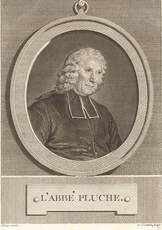 About Abbé Pluche:--pioneer in children's literature
About Abbé Pluche:--pioneer in children's literatureNoël-Antoine Pluche (1688 –1761) may have been the originator of changing “boring and disagreeable” dissertation into dialogue between a teacher and children. “Some will furnish our conversation with their knowledge and others will animate the discussion with their curiosity.” (Pluche quoted in Immel, Andrea, and Witmore, Michael. Childhood and Children's Books in Early Modern Europe, 1550-1800. United Kingdom, Taylor & Francis, 2013.)
P. Norbury & Son published at least three of Elizabeth Helme’s novels, including the posthumously-published Modern Times which was completed by her husband. Fun fact: the poet Percy Bysshe Shelley was an enthusiast for gothic novels as a teenager. He “would haunt the circulating library of Mr. P. Norbury in Brentford High Street” who carried “the same kind of extravagant fiction to which Shelley was addicted.” (from Shelley in England, New Facts and Letters from the Shelley-Whitton Papers, by Roger Ingpen, 1917.) Previous post: My discovery published
Published on September 24, 2025 00:00
September 2, 2025
CMP#226 I'm published in Notes & Queries
 This blog explores social attitudes in Jane Austen's time, discusses her novels, reviews forgotten 18th century novels, and throws
some occasional shade
at the modern academy. The introductory post is here. My "six simple questions for academics" post is here. Spoilers abound in my discussion of these forgotten novels, and I discuss 18th-century attitudes which I do not necessarily endorse. CMP#226 My article about one of Austen's youthful satires now online
This blog explores social attitudes in Jane Austen's time, discusses her novels, reviews forgotten 18th century novels, and throws
some occasional shade
at the modern academy. The introductory post is here. My "six simple questions for academics" post is here. Spoilers abound in my discussion of these forgotten novels, and I discuss 18th-century attitudes which I do not necessarily endorse. CMP#226 My article about one of Austen's youthful satires now online
 I've been juggling a few different topics here at Clutching My Pearls -- my investigation into who wrote the Regency novel The Woman of Colour, sorting out the tangled attribution chains of Mrs. E.G. Bayfield and Mrs. E.M. Foster, and recovering the tragic life of
Eliza Kirkham Mathews
. These three women are forgotten novelists of Jane Austen's era, but perhaps I should also write about Jane Austen now and then as well! After all this is a big anniversary year for her, the 250th anniversary of her birth. There are books and celebrations and articles and lectures galore.
I've been juggling a few different topics here at Clutching My Pearls -- my investigation into who wrote the Regency novel The Woman of Colour, sorting out the tangled attribution chains of Mrs. E.G. Bayfield and Mrs. E.M. Foster, and recovering the tragic life of
Eliza Kirkham Mathews
. These three women are forgotten novelists of Jane Austen's era, but perhaps I should also write about Jane Austen now and then as well! After all this is a big anniversary year for her, the 250th anniversary of her birth. There are books and celebrations and articles and lectures galore. Oh, and--lookee here! One article is by me! My short article, "An inspiration for Austen’s juvenile story Frederic and Elfrida" has been published by the venerable journal Notes & Queries. It's available online but only for those with a subscription or university access.
Frederic and Elfrida is a short juvenile piece of Jane Austen's and thought to be one her earliest, composed when she was only eleven or twelve years old. It begins with a satiric poke at the delicate reticence of the sentimental hero and heroine: THE Uncle of Elfrida was the Father of Frederic; in other words, they were first cousins by the Father's side. Being both born in one day & both brought up at one school, it was not wonderfull that they should look on each other with something more than bare politeness. They loved with mutual sincerity, but were both determined not to transgress the rules of Propriety by owning their attachment, either to the object beloved, or to any one else.
 My article suggests that the novel Elfrida, or Parental Ambition (1786), which I reviewed here, supplied the names and some of the plot points for Austen's juvenilia, and that we can reasonably assume that young Austen read Elfrida. I picture her reading, or listening to the book as it was read aloud in the family circle, and sharing a laugh with her family members over some of its sentimental excesses.
My article suggests that the novel Elfrida, or Parental Ambition (1786), which I reviewed here, supplied the names and some of the plot points for Austen's juvenilia, and that we can reasonably assume that young Austen read Elfrida. I picture her reading, or listening to the book as it was read aloud in the family circle, and sharing a laugh with her family members over some of its sentimental excesses. I suppose you'd have to be a real Janeite to find this discovery at all interesting! But I am convinced that there are lots of discoveries waiting to be made in the texts of the forgotten novels of the long 18th century. Discoveries about Austen, about women writers, about how English society viewed itself, and about the development of the novel.
Speaking of discoveries, I had already submitted my article when I came across an article by my dissertation supervisor, Professor Jennie Batchelor, sharing the discovery that forgotten novelist Phebe Gibbes was the author of Elfrida. Luckily, I was able to add a footnote to my article.
More discoveries to share in the future! Frederic and Elfrida has been published with a scholarly forward by Juvenilia Press. It is also available in various anthologies of Austen's juvenilia.
Published on September 02, 2025 00:00



